

Parts of Speech
What are the parts of speech, a formal definition.
Table of Contents
The Part of Speech Is Determined by the Word's Function
Are there 8 or 9 parts of speech, the nine parts of speech, (1) adjective, (3) conjunction, (4) determiner, (5) interjection, (7) preposition, (8) pronoun, why the parts of speech are important, video lesson.

- You need to dig a well . (noun)
- You look well . (adjective)
- You dance well . (adverb)
- Well , I agree. (interjection)
- My eyes will well up. (verb)
- red, happy, enormous
- Ask the boy in the red jumper.
- I live in a happy place.
- I caught a fish this morning! I mean an enormous one.
- happily, loosely, often
- They skipped happily to the counter.
- Tie the knot loosely so they can escape.
- I often walk to work.
- It is an intriguingly magic setting.
- He plays the piano extremely well.
- and, or, but
- it is a large and important city.
- Shall we run to the hills or hide in the bushes?
- I know you are lying, but I cannot prove it.
- my, those, two, many
- My dog is fine with those cats.
- There are two dogs but many cats.
- ouch, oops, eek
- Ouch , that hurt.
- Oops , it's broken.
- Eek! A mouse just ran past my foot!
- leader, town, apple
- Take me to your leader .
- I will see you in town later.
- An apple fell on his head .
- in, near, on, with
- Sarah is hiding in the box.
- I live near the train station.
- Put your hands on your head.
- She yelled with enthusiasm.
- she, we, they, that
- Joanne is smart. She is also funny.
- Our team has studied the evidence. We know the truth.
- Jack and Jill went up the hill, but they never returned.
- That is clever!
- work, be, write, exist
- Tony works down the pit now. He was unemployed.
- I will write a song for you.
- I think aliens exist .
Are you a visual learner? Do you prefer video to text? Here is a list of all our grammar videos .
Video for Each Part of Speech
The Most Important Writing Issues
The top issue related to adjectives.
| Don't write... | Do write... |
|---|---|
| very happy boy | delighted boy |
| very angry | livid |
| extremely posh hotel | luxurious hotel |
| really serious look | stern look |
The Top Issue Related to Adverbs
- Extremely annoyed, she stared menacingly at her rival.
- Infuriated, she glared at her rival.
The Top Issue Related to Conjunctions
- Burger, Fries, and a shake
- Fish, chips and peas
The Top Issue Related to Determiners
The Top Issue Related to Interjections
The top issue related to nouns, the top issue related to prepositions, the top issue related to pronouns, the top issue related to verbs.
| Unnatural (Overusing Nouns) | Natural (Using a Verb) |
|---|---|
| They are in agreement that he was in violation of several regulations. | They agree he violated several regulations. |
| She will be in attendance to present a demonstration of how the weather will have an effect on our process. | She will attend to demonstrate how the weather will affect our process. |
- Crack the parts of speech to help with learning a foreign language or to take your writing to the next level.

This page was written by Craig Shrives .
You might also like...
Help us improve....

Was something wrong with this page?

Use #gm to find us quicker .

Create a QR code for this, or any, page.
mailing list
grammar forum
teachers' zone
Confirmatory test.
This test is printable and sendable
expand to full page
show as slides
download as .doc
print as handout
send as homework
display QR code
Have a language expert improve your writing
Run a free plagiarism check in 10 minutes, generate accurate citations for free.
- Knowledge Base
- Parts of speech
The 8 Parts of Speech | Chart, Definition & Examples
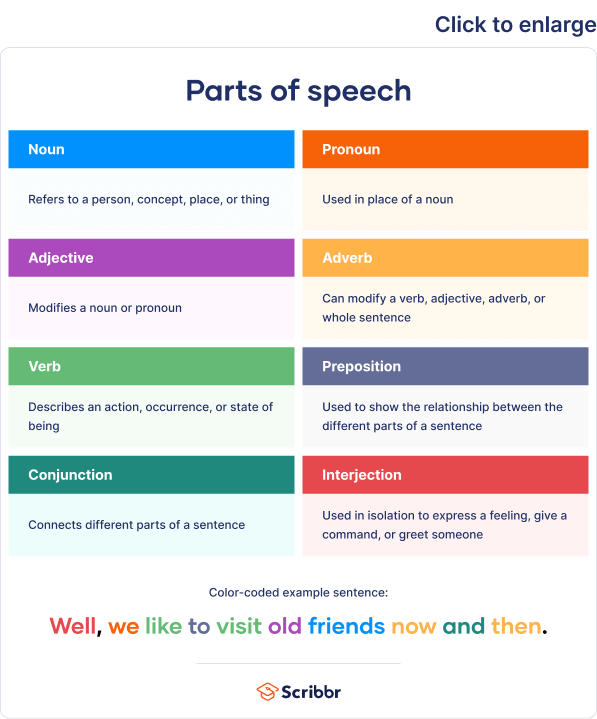
A part of speech (also called a word class ) is a category that describes the role a word plays in a sentence. Understanding the different parts of speech can help you analyze how words function in a sentence and improve your writing.
The parts of speech are classified differently in different grammars, but most traditional grammars list eight parts of speech in English: nouns , pronouns , verbs , adjectives , adverbs , prepositions , conjunctions , and interjections . Some modern grammars add others, such as determiners and articles .
Many words can function as different parts of speech depending on how they are used. For example, “laugh” can be a noun (e.g., “I like your laugh”) or a verb (e.g., “don’t laugh”).
You can check whether you’re using each of the parts of speech correctly using our grammar checker .
Table of contents
- Prepositions
- Conjunctions
- Interjections
Other parts of speech
Interesting language articles, frequently asked questions.
A noun is a word that refers to a person, concept, place, or thing. Nouns can act as the subject of a sentence (i.e., the person or thing performing the action) or as the object of a verb (i.e., the person or thing affected by the action).
There are numerous types of nouns, including common nouns (used to refer to nonspecific people, concepts, places, or things), proper nouns (used to refer to specific people, concepts, places, or things), and collective nouns (used to refer to a group of people or things).
Ella lives in France .
Other types of nouns include countable and uncountable nouns , concrete nouns , abstract nouns , and gerunds .
Check for common mistakes
Use the best grammar checker available to check for common mistakes in your text.
Fix mistakes for free
A pronoun is a word used in place of a noun. Pronouns typically refer back to an antecedent (a previously mentioned noun) and must demonstrate correct pronoun-antecedent agreement . Like nouns, pronouns can refer to people, places, concepts, and things.
There are numerous types of pronouns, including personal pronouns (used in place of the proper name of a person), demonstrative pronouns (used to refer to specific things and indicate their relative position), and interrogative pronouns (used to introduce questions about things, people, and ownership).
That is a horrible painting!
A verb is a word that describes an action (e.g., “jump”), occurrence (e.g., “become”), or state of being (e.g., “exist”). Verbs indicate what the subject of a sentence is doing. Every complete sentence must contain at least one verb.
Verbs can change form depending on subject (e.g., first person singular), tense (e.g., simple past), mood (e.g., interrogative), and voice (e.g., passive voice ).
Regular verbs are verbs whose simple past and past participle are formed by adding“-ed” to the end of the word (or “-d” if the word already ends in “e”). Irregular verbs are verbs whose simple past and past participles are formed in some other way.
“I’ve already checked twice.”
“I heard that you used to sing .”
Other types of verbs include auxiliary verbs , linking verbs , modal verbs , and phrasal verbs .
An adjective is a word that describes a noun or pronoun. Adjectives can be attributive , appearing before a noun (e.g., “a red hat”), or predicative , appearing after a noun with the use of a linking verb like “to be” (e.g., “the hat is red ”).
Adjectives can also have a comparative function. Comparative adjectives compare two or more things. Superlative adjectives describe something as having the most or least of a specific characteristic.
Other types of adjectives include coordinate adjectives , participial adjectives , and denominal adjectives .
An adverb is a word that can modify a verb, adjective, adverb, or sentence. Adverbs are often formed by adding “-ly” to the end of an adjective (e.g., “slow” becomes “slowly”), although not all adverbs have this ending, and not all words with this ending are adverbs.
There are numerous types of adverbs, including adverbs of manner (used to describe how something occurs), adverbs of degree (used to indicate extent or degree), and adverbs of place (used to describe the location of an action or event).
Talia writes quite quickly.
Other types of adverbs include adverbs of frequency , adverbs of purpose , focusing adverbs , and adverbial phrases .
A preposition is a word (e.g., “at”) or phrase (e.g., “on top of”) used to show the relationship between the different parts of a sentence. Prepositions can be used to indicate aspects such as time , place , and direction .
I left the cup on the kitchen counter.
A conjunction is a word used to connect different parts of a sentence (e.g., words, phrases, or clauses).
The main types of conjunctions are coordinating conjunctions (used to connect items that are grammatically equal), subordinating conjunctions (used to introduce a dependent clause), and correlative conjunctions (used in pairs to join grammatically equal parts of a sentence).
You can choose what movie we watch because I chose the last time.
An interjection is a word or phrase used to express a feeling, give a command, or greet someone. Interjections are a grammatically independent part of speech, so they can often be excluded from a sentence without affecting the meaning.
Types of interjections include volitive interjections (used to make a demand or request), emotive interjections (used to express a feeling or reaction), cognitive interjections (used to indicate thoughts), and greetings and parting words (used at the beginning and end of a conversation).
Ouch ! I hurt my arm.
I’m, um , not sure.
The traditional classification of English words into eight parts of speech is by no means the only one or the objective truth. Grammarians have often divided them into more or fewer classes. Other commonly mentioned parts of speech include determiners and articles.
- Determiners
A determiner is a word that describes a noun by indicating quantity, possession, or relative position.
Common types of determiners include demonstrative determiners (used to indicate the relative position of a noun), possessive determiners (used to describe ownership), and quantifiers (used to indicate the quantity of a noun).
My brother is selling his old car.
Other types of determiners include distributive determiners , determiners of difference , and numbers .
An article is a word that modifies a noun by indicating whether it is specific or general.
- The definite article the is used to refer to a specific version of a noun. The can be used with all countable and uncountable nouns (e.g., “the door,” “the energy,” “the mountains”).
- The indefinite articles a and an refer to general or unspecific nouns. The indefinite articles can only be used with singular countable nouns (e.g., “a poster,” “an engine”).
There’s a concert this weekend.
If you want to know more about nouns , pronouns , verbs , and other parts of speech, make sure to check out some of our language articles with explanations and examples.
Nouns & pronouns
- Common nouns
- Proper nouns
- Collective nouns
- Personal pronouns
- Uncountable and countable nouns
- Verb tenses
- Phrasal verbs
- Types of verbs
- Active vs passive voice
- Subject-verb agreement
A is an indefinite article (along with an ). While articles can be classed as their own part of speech, they’re also considered a type of determiner .
The indefinite articles are used to introduce nonspecific countable nouns (e.g., “a dog,” “an island”).
In is primarily classed as a preposition, but it can be classed as various other parts of speech, depending on how it is used:
- Preposition (e.g., “ in the field”)
- Noun (e.g., “I have an in with that company”)
- Adjective (e.g., “Tim is part of the in crowd”)
- Adverb (e.g., “Will you be in this evening?”)
As a part of speech, and is classed as a conjunction . Specifically, it’s a coordinating conjunction .
And can be used to connect grammatically equal parts of a sentence, such as two nouns (e.g., “a cup and plate”), or two adjectives (e.g., “strong and smart”). And can also be used to connect phrases and clauses.
Is this article helpful?
Other students also liked, what is a collective noun | examples & definition.
- What Is an Adjective? | Definition, Types & Examples
- Using Conjunctions | Definition, Rules & Examples
More interesting articles
- Definite and Indefinite Articles | When to Use "The", "A" or "An"
- Ending a Sentence with a Preposition | Examples & Tips
- What Are Prepositions? | List, Examples & How to Use
- What Is a Determiner? | Definition, Types & Examples
- What Is an Adverb? Definition, Types & Examples
- What Is an Interjection? | Examples, Definition & Types
"I thought AI Proofreading was useless but.."
I've been using Scribbr for years now and I know it's a service that won't disappoint. It does a good job spotting mistakes”
Parts of Speech: Definitions, Categories and Examples
By: Author English Study Online
Posted on Last updated: August 28, 2024
Sharing is caring!
In this reference, we will break down each part of speech and provide examples to help you understand their usage. We will also discuss how to identify the different parts of speech in a sentence and provide tips on how to use them correctly. Let’s get started!

Parts of Speech – Created by Englishstudyonline
Table of Contents
What is a Parts of Speech?
A part of speech is a category that describes the role a word plays in a sentence. These roles help you understand how words function in grammar .
There are typically eight main parts of speech in English:
- Nouns : Words that name people, places, things, or ideas.
- Pronouns : Words that replace nouns, such as he, she, it .
- Verbs : Words that describe actions or states, like run, is .
- Adjectives : Words that describe or modify nouns, like blue or quick .
Some grammars list additional parts of speech:
- Adverbs : Words that modify verbs, adjectives, or other adverbs, such as quickly .
- Prepositions : Words that show relationships between a noun (or pronoun) and another word, like in or on .
- Conjunctions : Words that connect clauses, sentences, or words, such as and or but .
- Interjections : Words that express emotion, like wow or oops .
Some sources also include:
- Determiners/Articles : Words that modify nouns and specify which one, like the, a .
Categories of Parts of Speech
Nouns are words that represent people, places, things, or ideas. They are one of the most important parts of speech in English and are used in nearly every sentence. In this section, we will explore the different types of nouns and their functions.
- Common Nouns : General names for people, places, or things. Not capitalized unless at the start of a sentence. Examples : “book,” “city,” “teacher.”
- Proper Nouns : Specific names for people, places, or things. Always capitalized. Examples : “Harry Potter,” “New York City,” “Ms. Johnson.”
- Abstract Nouns : Names for ideas, concepts, or emotions that are intangible. Examples : “love,” “happiness,” “freedom.”
- Collective Nouns : Names for groups of people or things; can be singular or plural. Examples : “team,” “family,” “herd.”
2. Pronouns
Pronouns are words that replace nouns in a sentence. They help avoid repetition and make sentences clearer. Here are different types of pronouns in English:
- Personal Pronouns : Refer to specific people or things and can be subjects or objects. Examples : I/me, you/your/yours, he/him/his, she/her/hers, it/its.
- Demonstrative Pronouns : Point to specific people or things and indicate distance. Examples : this (near), that (far), these (plural, near), those (plural, far).
- Interrogative Pronouns : Used to ask questions. Examples : who (person), whom (person, object), whose (possession).
- Indefinite Pronouns : Refer to non-specific people or things. Examples : anybody, anyone, anything, each, either, everybody, everyone, everything.
- Action Verbs : Describe actions performed by the subject. Examples : Run, Jump, Sing, Dance, Write.
- Linking Verbs : Connect the subject to a noun, pronoun, or adjective that describes it; they do not show action. Examples : Is, Are, Was, Were, Seem.
- Helping Verbs : Work with the main verb to express tense, voice, or mood; they have no meaning on their own. Examples : Am, Is, Are, Was, Were.
4. Adjectives
Adjectives are words that describe or modify nouns or pronouns, giving more information about their qualities, quantity, or identity. Here are three types of adjectives:
- Descriptive Adjectives : Describe the characteristics or qualities of a noun or pronoun. Examples : Beautiful, Tall, Thin, Ugly, Smart, Kind. Sentence Example : “The red car is fast.” (“red” describes the color; “fast” describes the speed).
- Quantitative Adjectives : Indicate the quantity or amount of a noun or pronoun, answering “how much” or “how many.” Examples : Few, Many, Several, Some, All, No. Sentence Example : “I have two apples.” (“two” describes the number of apples).
- Demonstrative Adjectives : Point to specific nouns or pronouns, answering “which one” or “whose.” Examples : This, That, These, Those. Sentence Example : “This book is mine.” (“this” specifies the book).
Adverbs modify verbs, adjectives, or other adverbs, providing more detail about an action, adverbs of manner, adverbs of place, adverbs of time, adverbs of frequency , adverbs of degree, or intensity.
Examples of adverbs:
- I left my keys here . (Adverb of place)
- She arrived late because she missed the bus. (Adverb of time)
- James visits his grandmother weekly . (Adverb of frequency)
- Please drive carefully on the wet roads. (Adverb of manner)
- She was extremely tired after the long journey. (Adverb of degree)
6. Prepositions
Prepositions are words that show the relationship between a noun or pronoun and other words in a sentence, indicating position, direction, or time.
Prepositions of Time : Indicate when an action takes place. Examples :
- “At” for specific times: “at 2 pm,” “at midnight.”
- “In” for longer periods: “in the morning,” “in October.”
- “On” for dates: “on Monday,” “on July 4th.”
Prepositions of Place : Indicate where something is located. Examples :
- “In” for enclosed spaces: “in the house,” “in the car.”
- “On” for surfaces: “on the table,” “on the floor.”
- “At” for specific locations: “at the park,” “at the beach.”
Prepositions of Direction : Indicate movement from one place to another. Examples :
- “To” for movement towards: “I am going to the store.”
- “From” for movement away: “I am coming from the park.”
- “Towards” for movement in a direction: “I am walking towards the museum.”
7. Conjunctions
Conjunctions are words that connect words, phrases, or clauses in a sentence, helping to create complex sentences and showing relationships between ideas. There are three main types of conjunctions: coordinating, subordinating, and correlative.
Coordinating Conjunctions : Connect words, phrases, or independent clauses of equal importance. Remember them using FANBOYS : for, and, nor, but, or, yet, so. Examples :
- “I like pizza and pasta .”
- “He wanted to go to the beach, but it was raining.”
Subordinating Conjunctions : Connect dependent clauses to independent clauses, showing relationships like cause and effect, time, condition, or contrast. Examples : because, although, while, if, unless, since.
- “Because it was raining, we stayed inside.”
- “While I was studying, my roommate was watching TV.”
Correlative Conjunctions : Work in pairs to connect elements in a sentence, showing a relationship between them. Examples : both…and, either…or, neither…nor, not only…but also.
- “Both my sister and I like to read.”
- “Not only was he late, but he also forgot his homework.”
8. Interjections
In English grammar, interjections are words or phrases that express strong emotions or feelings. They are also known as exclamations and are one of the eight parts of speech in English. Interjections are grammatically independent from the words around them, and they can often be removed from a sentence or context without affecting its basic meaning.
Interjections can be used to express a wide range of emotions, including surprise, joy, anger, frustration, and pain. Some common examples of interjections include “ wow ,” “ ouch ,” “ yay ,” “ oh no ,” and “ oops .” They can be used to add emphasis to a sentence or to convey a particular tone or mood.
9. Articles/Determiners
In English grammar, articles and determiners are words that are used with nouns to provide more information about them. They help us to understand the context and meaning of a sentence.
There are three articles in the English language: “ the ,” “ a, ” and “ an. ” “The” is known as the definite article because it refers to a specific noun that has already been mentioned or is known to the reader. For example, “The cat is sleeping on the sofa.” In this sentence, “the” refers to a specific cat that has already been mentioned or is known to the reader.
“A” and “an” are known as indefinite articles because they refer to any member of a group or class of nouns. “A” is used before words that begin with a consonant sound, while “an” is used before words that begin with a vowel sound. For example, “I need a pen” and “She ate an apple.”
Determiners
Determiners are words that come before a noun to provide more information about it. They can include articles, as well as words like “ this ,” “ that ,” “ these ,” and “ those .”
In addition to these, there are other types of determiners such as possessive determiners (e.g. “my,” “your,” “his,” “her,” “its,” “our,” and “their”), demonstrative determiners (e.g. “this,” “that,” “these,” and “those”), and quantifying determiners (e.g. “some,” “any,” “many,” “few,” “several,” etc.).
Determiners can also be used with adjectives to provide more information about a noun. For example, “She ate the delicious apple” and “I saw that beautiful sunset.”
Examples of Parts of Speech
- Noun – The dog barked loudly.
- Pronoun – They went to the park together.
- Verb – She writes beautiful poetry.
- Adverb – He runs very quickly.
- Adjective – The red car is fast.
- Preposition – The cat is sitting on the sofa.
- Conjunction – She wanted to go for a walk, and he wanted to stay home.
- Interjection – Wow! That was an incredible performance.
Practical Exercises
Exercise 1: Identify the Part of Speech
Read each sentence and identify the underlined word’s part of speech (Noun, Pronoun, Verb, Adverb, Adjective, Preposition, Conjunction, Interjection).
- The beautiful garden is full of flowers.
- She quickly finished her homework.
- Wow! That was a great surprise.
- The cat hid under the bed.
- I want to go out, but it’s raining.
- He is a very talented musician.
- The children play in the park every evening.
- The cake is delicious .
- After lunch, we went for a walk.
- They will arrive at the airport soon.
- Interjection
- Preposition
- Conjunction
Exercise 2: Fill in the Blanks with the Correct Part of Speech
Choose the correct word from the list and fill in the blanks with the appropriate part of speech.
Word List: (and, beautiful, suddenly, them, book, Wow, under, write, she, quickly)
- The weather is so __________ today.
- I have to __________ an essay for my class.
- He ran __________ to catch the bus.
- The ball rolled __________ the table.
- They read a __________ together every night.
- She wanted to go to the park, __________ it started raining.
- Can you give this note to __________?
- __________! That was an amazing goal!
- __________ is going to the market.
- The bird flew away __________.
- beautiful (Adjective)
- write (Verb)
- quickly (Adverb)
- under (Preposition)
- book (Noun)
- and (Conjunction)
- them (Pronoun)
- Wow (Interjection)
- She (Pronoun)
- suddenly (Adverb)
- Recent Posts
- Juridical Process vs. Judicial Process: Understanding the Crucial Differences - December 14, 2023
- Compound Nouns: How to Use Them Effectively in English - November 9, 2023
- English Tenses: A Beginner’s Guide in English - November 6, 2023
Instantly enhance your writing in real-time while you type. With LanguageTool
Get started for free
Understanding the Parts of Speech in English
Yes, the parts of speech in English are extensive and complex. But we’ve made it easy for you to start learning them by gathering the most basic and essential information in this easy-to-follow and comprehensive guide.

Parts of Speech: Quick Summary
Parts of speech assign words to different categories. There are eight different types in English. Keep in mind that a word can belong to more than one part of speech.
Learn About:
- Parts of Speech
- Prepositions
- Conjunctions
- Interjections
Using the Parts of Speech Correctly In Your Writing
Knowing the parts of speech is vital when learning a new language.
When it comes to learning a new language, there are several components you should understand to truly get a grasp of the language and speak it fluently.
It’s not enough to become an expert in just one area. For instance, you can learn and memorize all the intricate grammar rules, but if you don’t practice speaking or writing colloquially, you will find it challenging to use that language in real time.
Conversely, if you don’t spend time trying to learn the rules and technicalities of a language, you’ll also find yourself struggling to use it correctly.
Think of it this way: Language is a tasty, colorful, and nutritious salad. If you fill your bowl with nothing but lettuce, your fluency will be bland, boring, and tasteless. But if you spend time cultivating other ingredients for your salad—like style, word choice, and vocabulary— then it will become a wholesome meal you can share with others.
In this blog post, we’re going to cover one of the many ingredients you’ll need to build a nourishing salad of the English language—the parts of speech.
LanguageTool's Paraphrasing Tool can also help you use the different parts of speech effectively in your writing.
Let’s get choppin’!
What Are the Parts of Speech in English?
The parts of speech refer to categories to which a word belongs. In English, there are eight of them : verbs , nouns, pronouns, adjectives, adverbs, prepositions, conjunctions, and interjections.
Many English words fall into more than one part of speech category. Take the word light as an example. It can function as a verb, noun, or adjective.
Verb: Can you please light the candles?
Noun: The room was filled with a dim, warm light .
Adjective: She wore a light jacket in the cool weather.
The parts of speech in English are extensive. There’s a lot to cover in each category—much more than we can in this blog post. The information below is simply a brief overview of the basics of the parts of speech. Nevertheless, the concise explanations and accompanying example sentences will help you gain an understanding of how to use them correctly.

What Are Verbs?
Verbs are the most essential parts of speech because they move the meaning of sentences along.
A verb can show actions of the body and mind ( jump and think ), occurrences ( happen or occur ), and states of being ( be and exist ). Put differently, verbs breathe life into sentences by describing actions or indicating existence. These parts of speech can also change form to express time , person , number , voice , and mood .
There are several verb categories. A few of them are:
- Regular and irregular verbs
- Transitive and intransitive verbs
- Auxiliary verbs
A few examples of verbs include sing (an irregular action verb), have (which can be a main verb or auxiliary verb), be , which is a state of being verb, and would (another auxiliary verb).
My little sister loves to sing .
I have a dog and her name is Sweet Pea.
I will be there at 5 P.M.
I would like to travel the world someday.
Again, these are just the very basics of English verbs. There’s a lot more that you should learn to be well-versed in this part of speech, but the information above is a good place to start.
What Are Nouns?
Nouns refer to people ( John and child ), places ( store and Italy ), things ( firetruck and pen ), and ideas or concepts ( love and balance ). There are also many categories within nouns. For example, proper nouns name a specific person, place, thing, or idea. These types of nouns are always capitalized.
Olivia is turning five in a few days.
My dream is to visit Tokyo .
The Supreme Court is the highest court in the United States.
Some argue that Buddhism is a way of life, not a religion.
On the other hand, common nouns are not specific to any particular entity and are used to refer to any member of a general category.
My teacher is the smartest, most caring person I know!
I love roaming around a city I’ve never been to before.
This is my favorite book , which was recommended to me by my father.
There’s nothing more important to me than love .
Nouns can be either singular or plural. Singular nouns refer to a single entity, while plural nouns refer to multiple entities.
Can you move that chair out of the way, please? (Singular)
Can you move those chairs out of the way, please? (Plural)
While many plural nouns are formed by adding an “–s” or “–es,” others have irregular plural forms, meaning they don’t follow the typical pattern.
There was one woman waiting in line.
There were several women waiting in line.
Nouns can also be countable or uncountable . Those that are countable refer to nouns that can be counted as individual units. For example, there can be one book, two books, three books, or more. Uncountable nouns cannot be counted as individual units. Take the word water as an example. You could say I drank some water, but it would be incorrect to say I drank waters. Instead, you would say something like I drank several bottles of water.
What Are Pronouns?
A pronoun is a word that can take the place of other nouns or noun phrases. Pronouns serve the purpose of referring to nouns without having to repeat the word each time. A word (or group of words) that a pronoun refers to is called the antecedent .
Jessica went to the store, and she bought some blueberries.
In the sentence above, Jessica is the antecedent, and she is the referring pronoun. Here’s the same sentence without the proper use of a pronoun:
Jessica went to the store, and Jessica bought some blueberries.
Do you see how the use of a pronoun improves the sentence by avoiding repetitiveness?
Like all the other parts of speech we have covered, pronouns also have various categories.
Personal pronouns replace specific people or things: I, me, you, he, she, him, her, it, we, us, they, them.
When I saw them at the airport, I waved my hands up in the air so they could see me .
Possessive pronouns indicate ownership : mine, ours, yours, his, hers, theirs, whose.
I think that phone is hers .
Reflexive pronouns refer to the subject of a sentence or clause. They are used when the subject and the object of a sentence refer to the same person or thing: myself, yourself, himself, herself, itself, ourselves, yourselves, themselves.
The iguanas sunned themselves on the roof of my car.
Intensive pronouns have the same form as reflexive pronouns and are used to emphasize or intensify the subject of a sentence.
I will take care of this situation myself .
Indefinite pronouns do not refer to specific individuals or objects but rather to a general or unspecified person, thing, or group. Some examples include someone, everybody, anything, nobody, each, something, and all.
Everybody enjoyed the party. Someone even said it was the best party they had ever attended.
Demonstrative pronouns are used to identify or point to specific pronouns: this, that, these, those.
Can you pick up those pens off the floor?
Interrogative pronouns are used to ask questions and seek information: who, whom, whose, which, what.
Who can help move these heavy boxes?
Relative pronouns connect a clause or a phrase to a noun or pronoun: who, whom, whose, which, that, what, whoever, whichever, whatever.
Christina, who is the hiring manager, is the person whom you should get in touch with.
Reciprocal pronouns are used to refer to individual parts of a plural antecedent. They indicate a mutual or reciprocal relationship between two or more people or things: each other or one another.
The cousins always giggle and share secrets with one another .
What Are Adjectives?
Adjectives modify nouns or pronouns, usually by describing, identifying, or quantifying them. They play a vital role in adding detail, precision, and imagery to English, allowing us to depict and differentiate the qualities of people, objects, places, and ideas.
The blue house sticks out compared to the other neutral-colored ones. (Describes)
That house is pretty, but I don’t like the color. (Identifies)
There were several houses I liked, but the blue one was unique. (Quantifies)
We should note that identifying or quantifying adjectives are also referred to as determiners. Additionally, articles ( a, an, the ) and numerals ( four or third ) are also used to quantify and identify adjectives.
Descriptive adjectives have other forms (known as comparative and superlative adjectives ) that allow for comparisons. For example, the comparative of the word small is smaller, while the superlative is smallest.
Proper adjectives (which are derived from proper nouns) describe specific nouns. They usually retain the same spelling or are slightly modified, but they’re always capitalized. For example, the proper noun France can be turned into the proper adjective French.
What Are Adverbs?
Adverbs are words that modify or describe verbs, adjectives, other adverbs, or entire clauses. Although many adverbs end in “–ly,” not all of them do. Also, some words that end in “–ly” are adjectives, not adverbs ( lovely ).
She dances beautifully .
In the sentence above, beautifully modifies the verb dances.
We visited an extremely tall building.
Here, the adverb extremely modifies the adjective tall.
He had to run very quickly to not miss the train.
The adverb very modifies the adverb quickly.
Interestingly , the experiment yielded unexpected results that left us baffled.
In this example, the word interestingly modifies the independent clause that comprises the rest of the sentence (which is why they’re called sentence adverbs ).
Like adjectives, adverbs can also have other forms when making comparisons. For example:
strongly, more strongly, most strongly, less strongly, least strongly
What Are Prepositions?
Prepositions provide context and establish relationships between nouns, pronouns, and other words in a sentence. They indicate time, location, direction, manner, and other vital information. Prepositions can fall into several subcategories. For instance, on can indicate physical location, but it can also be used to express time.
Place the bouquet of roses on the table.
We will meet on Monday.
There are many prepositions. A few examples include: about, above, across, after, before, behind, beneath, beside, during, except, for, from, in, inside, into, like, near, of, off, onto, past, regarding, since, through, toward, under, until, with, without.
Prepositions can contain more than one word, like according to and with regard to.
What Are Conjunctions?
Conjunctions are words that join words, phrases, or clauses together within a sentence and provide information about the relationship between those words. There are different types of conjunctions.
Coordinating conjunctions connect words, phrases, or clauses of equal importance: and, but, for, not, or, so, yet.
I like to sing, and she likes to dance.
Correlative conjunctions come in pairs and join balanced elements of a sentence: both…and, just as…so, not only…but also, either…or, neither…nor, whether…or.
You can either come with us and have fun, or stay at home and be bored.
Subordinating conjunctions connect dependent clauses to independent clauses. A few examples include: after, although, even though, since, unless, until, when , and while.
They had a great time on their stroll, even though it started raining and they got soaked.
Conjunctive adverbs are adverbs that function as conjunctions, connecting independent clauses or sentences. Examples of conjunctive adverbs are also, anyway, besides, however, meanwhile, nevertheless, otherwise, similarly, and therefore .
I really wanted to go to the party. However , I was feeling sick and decided to stay in.
I really wanted to go to the party; however , I was feeling sick and decided to stay in.
What Are Interjections?
Interjections are words that express strong emotions, sudden reactions, or exclamations. This part of speech is usually a standalone word or phrase, but even when it is part of a sentence, it does not relate grammatically to the rest of .
There are several interjections. Examples include: ahh, alas, bravo, eww, hello, please, thanks, and oops.
Ahh ! I couldn’t believe what was happening.
When it comes to improving your writing skills, understanding the parts of speech is as important as adding other ingredients besides lettuce to a salad.
The information provided above is indeed extensive, but it’s critical to learn if you want to write effectively and confidently. LanguageTool—a multilingual writing assistant—makes comprehending the parts of speech easy by detecting errors as you write.
Give it a try—it’s free!

Unleash the Professional Writer in You With LanguageTool
Go well beyond grammar and spell checking. Impress with clear, precise, and stylistically flawless writing instead.
Works on All Your Favorite Services
- Thunderbird
- Google Docs
- Microsoft Word
- Open Office
- Libre Office
We Value Your Feedback
We’ve made a mistake, forgotten about an important detail, or haven’t managed to get the point across? Let’s help each other to perfect our writing.
Welcome to the new OASIS website! We have academic skills, library skills, math and statistics support, and writing resources all together in one new home.

- Walden University
- Faculty Portal
Grammar: Main Parts of Speech
Definitions and examples.
The name of something, like a person, animal, place, thing, or concept. Nouns are typically used as subjects, objects, objects of prepositions, and modifiers of other nouns.
- I = subject
- the dissertation = object
- in Chapter 4 = object of a preposition
- research = modifier
This expresses what the person, animal, place, thing, or concept does. In English, verbs follow the noun.
- It takes a good deal of dedication to complete a doctoral degree.
- She studied hard for the test.
- Writing a dissertation is difficult. (The "be" verb is also sometimes referred to as a copula or a linking verb. It links the subject, in this case "writing a dissertation," to the complement or the predicate of the sentence, in this case, "hard.")
This describes a noun or pronoun. Adjectives typically come before a noun or after a stative verb, like the verb "to be."
- Diligent describes the student and appears before the noun student .
- Difficult is placed after the to be verb and describes what it is like to balance time.
Remember that adjectives in English have no plural form. The same form of the adjective is used for both singular and plural nouns.
- A different idea
- Some different ideas
- INCORRECT: some differents ideas
This gives more information about the verb and about how the action was done. Adverbs tells how, where, when, why, etc. Depending on the context, the adverb can come before or after the verb or at the beginning or end of a sentence.
- Enthusiastically describes how he completed the course and answers the how question.
- Recently modifies the verb enroll and answers the when question.
- Then describes and modifies the entire sentence. See this link on transitions for more examples of conjunctive adverbs (adverbs that join one idea to another to improve the cohesion of the writing).
This word substitutes for a noun or a noun phrase (e.g. it, she, he, they, that, those,…).
- they = applicants
- He = Smith; that = ideas; those = those ideas
This word makes the reference of the noun more specific (e.g. his, her, my, their, the, a, an, this, these, … ).
- Jones published her book in 2015.
- The book was very popular.
Preposition
This comes before a noun or a noun phrase and links it to other parts of the sentence. These are usually single words (e.g., on, at, by ,… ) but can be up to four words (e.g., as far as, in addition to, as a result of, …).
- I chose to interview teachers in the district closest to me.
- The recorder was placed next to the interviewee.
- I stopped the recording in the middle of the interview due to a low battery.
Conjunction
A word that joins two clauses. These can be coordinating (an easy way to remember this is memorizing FANBOYS = for, and, nor, but, or, yet, so) or subordinating (e.g., because, although, when, …).
- The results were not significant, so the alternative hypothesis was accepted.
- Although the results seem promising, more research must be conducted in this area.
Auxiliary Verbs
Helping verbs. They are used to build up complete verbs.
- Primary auxiliary verbs (be, have, do) show the progressive, passive, perfect, and negative verb tenses .
- Modal auxiliary verbs (can, could, may, might, must, shall, should, will, would) show a variety of meanings. They represent ability, permission, necessity, and degree of certainty. These are always followed by the simple form of the verb.
- Semimodal auxiliary verbs (e.g., be going to, ought to, have to, had better, used to, be able to,…). These are always followed by the simple form of the verb.
- primary: have investigated = present perfect tense; has not been determined = passive, perfect, negative form
- The modal could shows ability, and the verb conduct stays in its simple form; the modal may shows degree of certainty, and the verb lead stays in its simple form.
- These semimodals are followed by the simple form of the verb.
Common Endings
Nouns, verbs, adjectives, and adverbs often have unique word endings, called suffixes . Looking at the suffix can help to distinguish the word from other parts of speech and help identify the function of the word in the sentence. It is important to use the correct word form in written sentences so that readers can clearly follow the intended meaning.
Here are some common endings for the basic parts of speech. If ever in doubt, consult the dictionary for the correct word form.
Common Noun Endings
| suffrage, image, postage arrival, survival, deferral : kingdom, freedom, boredom : interviewee, employee, trainee : experience, convenience, finance teacher, singer, director archery, cutlery, mystery neighborhood, childhood, brotherhood : economics, gymnastics, aquatics reading, succeeding, believing racism, constructivism, capitalism community, probability, equality : accomplishment, acknowledgement, environment happiness, directness, business : ministry, entry, robbery : scholarship, companionship, leadership : information, expression, complexion structure, pressure, treasure |
Common Verb Endings
| congregate, agitate, eliminate : straighten, enlighten, shorten : satisfy, identify, specify : categorize, materialize, energize |
Common Adjective Endings
| workable, believable, flexible educational, institutional, exceptional : confused, increased, disappointed : wooden, golden, broken : Chinese, Portuguese, Japanese wonderful, successful, resourceful : poetic, classic, Islamic exciting, failing, comforting childish, foolish, selfish evaluative, collective, abrasive : Canadian, Russian, Malaysian priceless, useless, hopeless friendly, daily, yearly gorgeous, famous, courageous funny, windy, happy |
Common Adverb Endings
| : quickly, easily, successfully backward(s), upwards, downwards clockwise, edgewise, price-wise |
Placement and Position of Adjectives and Adverbs
Order of adjectives.
If more than one adjective is used in a sentence, they tend to occur in a certain order. In English, two or three adjectives modifying a noun tend to be the limit. However, when writing in APA, not many adjectives should be used (since APA is objective, scientific writing). If adjectives are used, the framework below can be used as guidance in adjective placement.
- Determiner (e.g., this, that, these, those, my, mine, your, yours, him, his, hers they, their, some, our, several,…) or article (a, an, the)
- Opinion, quality, or observation adjective (e.g., lovely, useful, cute, difficult, comfortable)
- Physical description
- (a) size (big, little, tall, short)
- (b) shape (circular, irregular, triangular)
- (c) age (old, new, young, adolescent)
- (d) color (red, green, yellow)
- Origin (e.g., English, Mexican, Japanese)
- Material (e.g., cotton, metal, plastic)
- Qualifier (noun used as an adjective to modify the noun that follows; i.e., campus activities, rocking chair, business suit)
- Head noun that the adjectives are describing (e.g., activities, chair, suit)
For example:
- This (1) lovely (2) new (3) wooden (4) Italian (5) rocking (6) chair (7) is in my office.
- Your (1) beautiful (2) green (3) French (4) silk (5) business (6) suit (7) has a hole in it.
Commas With Multiple Adjectives
A comma is used between two adjectives only if the adjectives belong to the same category (for example, if there are two adjectives describing color or two adjectives describing material). To test this, ask these two questions:
- Does the sentence make sense if the adjectives are written in reverse order?
- Does the sentence make sense if the word “and” is written between them?
If the answer is yes to the above questions, the adjectives are separated with a comma. Also keep in mind a comma is never used before the noun that it modifies.
- This useful big round old green English leather rocking chair is comfortable . (Note that there are no commas here because there is only one adjective from each category.)
- A lovely large yellow, red, and green oil painting was hung on the wall. (Note the commas between yellow, red, and green since these are all in the same category of color.)
Position of Adverbs
Adverbs can appear in different positions in a sentence.
- At the beginning of a sentence: Generally , teachers work more than 40 hours a week.
- After the subject, before the verb: Teachers generally work more than 40 hours a week.
- At the end of a sentence: Teachers work more than 40 hours a week, generally .
- However, an adverb is not placed between a verb and a direct object. INCORRECT: Teachers work generally more than 40 hours a week.
More Detailed Rules for the Position of Adverbs
- Adverbs that modify the whole sentence can move to different positions, such as certainly, recently, fortunately, actually, and obviously.
- Recently , I started a new job.
- I recently started a new job.
- I started a new job recently .
- Many adverbs of frequency modify the entire sentence and not just the verb, such as frequently, usually, always, sometimes, often , and seldom . These adverbs appear in the middle of the sentence, after the subject.
- INCORRECT: Frequently she gets time to herself.
- INCORRECT: She gets time to herself frequently .
- She has frequently exercised during her lunch hour. (The adverb appears after the first auxiliary verb.)
- She is frequently hanging out with old friends. (The adverb appears after the to be verb.)
- Adverbial phrases work best at the end of a sentence.
- He greeted us in a very friendly way .
- I collected data for 2 months .
Main Parts of Speech Video Playlist
Note that these videos were created while APA 6 was the style guide edition in use. There may be some examples of writing that have not been updated to APA 7 guidelines.
- Mastering the Mechanics: Nouns (video transcript)
- Mastering the Mechanics: Introduction to Verbs (video transcript)
- Mastering the Mechanics: Articles (video transcript)
- Mastering the Mechanics: Introduction to Pronouns (video transcript)
- Mastering the Mechanics: Modifiers (video transcript)
Writing Tools: Dictionary and Thesaurus Refresher Video
Note that this video was created while APA 6 was the style guide edition in use. There may be some examples of writing that have not been updated to APA 7 guidelines.
- Writing Tools: Dictionary and Thesaurus Refresher (video transcript)
Related Resources
Knowledge Check: Main Parts of Speech
Didn't find what you need? Email us at [email protected] .
- Previous Page: Grammar
- Next Page: Sentence Structure and Types of Sentences
- Office of Student Disability Services
Walden Resources
Departments.
- Academic Residencies
- Academic Skills
- Career Planning and Development
- Customer Care Team
- Field Experience
- Military Services
- Student Success Advising
- Writing Skills
Centers and Offices
- Center for Social Change
- Office of Academic Support and Instructional Services
- Office of Degree Acceleration
- Office of Research and Doctoral Services
- Office of Student Affairs
Student Resources
- Doctoral Writing Assessment
- Form & Style Review
- Quick Answers
- ScholarWorks
- SKIL Courses and Workshops
- Walden Bookstore
- Walden Catalog & Student Handbook
- Student Safety/Title IX
- Legal & Consumer Information
- Website Terms and Conditions
- Cookie Policy
- Accessibility
- Accreditation
- State Authorization
- Net Price Calculator
- Cost of Attendance
- Contact Walden
Walden University is a member of Adtalem Global Education, Inc. www.adtalem.com Walden University is certified to operate by SCHEV © 2024 Walden University LLC. All rights reserved.
- Humanities ›
- English Grammar ›
The 9 Parts of Speech: Definitions and Examples
- Ph.D., Rhetoric and English, University of Georgia
- M.A., Modern English and American Literature, University of Leicester
- B.A., English, State University of New York
A part of speech is a term used in traditional grammar for one of the nine main categories into which words are classified according to their functions in sentences, such as nouns or verbs. Also known as word classes, these are the building blocks of grammar.
Every sentence you write or speak in English includes words that fall into some of the nine parts of speech. These include nouns, pronouns, verbs, adjectives, adverbs, prepositions, conjunctions, articles/determiners, and interjections. (Some sources include only eight parts of speech and leave interjections in their own category.)
Parts of Speech
- Word types can be divided into nine parts of speech:
- prepositions
- conjunctions
- articles/determiners
- interjections
- Some words can be considered more than one part of speech, depending on context and usage.
- Interjections can form complete sentences on their own.
Learning the names of the parts of speech probably won't make you witty, healthy, wealthy, or wise. In fact, learning just the names of the parts of speech won't even make you a better writer. However, you will gain a basic understanding of sentence structure and the English language by familiarizing yourself with these labels.
Open and Closed Word Classes
The parts of speech are commonly divided into open classes (nouns, verbs, adjectives, and adverbs) and closed classes (pronouns, prepositions, conjunctions, articles/determiners, and interjections). Open classes can be altered and added to as language develops, and closed classes are pretty much set in stone. For example, new nouns are created every day, but conjunctions never change.
In contemporary linguistics , parts of speech are generally referred to as word classes or syntactic categories. The main difference is that word classes are classified according to more strict linguistic criteria. Within word classes, there is the lexical, or open class, and the function, or closed class.
The 9 Parts of Speech
Read about each part of speech below, and practice identifying each.
Nouns are a person, place, thing, or idea. They can take on a myriad of roles in a sentence, from the subject of it all to the object of an action. They are capitalized when they're the official name of something or someone, and they're called proper nouns in these cases. Examples: pirate, Caribbean, ship, freedom, Captain Jack Sparrow.
Pronouns stand in for nouns in a sentence . They are more generic versions of nouns that refer only to people. Examples: I, you, he, she, it, ours, them, who, which, anybody, ourselves.
Verbs are action words that tell what happens in a sentence. They can also show a sentence subject's state of being ( is , was ). Verbs change form based on tense (present, past) and count distinction (singular or plural). Examples: sing, dance, believes, seemed, finish, eat, drink, be, became.
Adjectives describe nouns and pronouns. They specify which one, how much, what kind, and more. Adjectives allow readers and listeners to use their senses to imagine something more clearly. Examples: hot, lazy, funny, unique, bright, beautiful, poor, smooth.
Adverbs describe verbs, adjectives, and even other adverbs. They specify when, where, how, and why something happened and to what extent or how often. Many adjectives can be turned into adjectives by adding the suffix - ly . Examples: softly, quickly, lazily, often, only, hopefully, sometimes.
Preposition
Prepositions show spatial, temporal, and role relations between a noun or pronoun and the other words in a sentence. They come at the start of a prepositional phrase , which contains a preposition and its object. Examples: up, over, against, by, for, into, close to, out of, apart from.
Conjunction
Conjunctions join words, phrases, and clauses in a sentence. There are coordinating, subordinating, and correlative conjunctions. Examples: and, but, or, so, yet.
Articles and Determiners
Articles and determiners function like adjectives by modifying nouns, but they are different than adjectives in that they are necessary for a sentence to have proper syntax. Articles and determiners specify and identify nouns, and there are indefinite and definite articles. Examples of articles: a, an, the ; examples of determiners: these, that, those, enough, much, few, which, what.
Some traditional grammars have treated articles as a distinct part of speech. Modern grammars, however, more often include articles in the category of determiners , which identify or quantify a noun. Even though they modify nouns like adjectives, articles are different in that they are essential to the proper syntax of a sentence, just as determiners are necessary to convey the meaning of a sentence, while adjectives are optional.
Interjection
Interjections are expressions that can stand on their own or be contained within sentences. These words and phrases often carry strong emotions and convey reactions. Examples: ah, whoops, ouch, yabba dabba do!
How to Determine the Part of Speech
Only interjections ( Hooray! ) have a habit of standing alone; every other part of speech must be contained within a sentence and some are even required in sentences (nouns and verbs). Other parts of speech come in many varieties and may appear just about anywhere in a sentence.
To know for sure what part of speech a word falls into, look not only at the word itself but also at its meaning, position, and use in a sentence.
For example, in the first sentence below, work functions as a noun; in the second sentence, a verb; and in the third sentence, an adjective:
- Bosco showed up for work two hours late.
- The noun work is the thing Bosco shows up for.
- He will have to work until midnight.
- The verb work is the action he must perform.
- His work permit expires next month.
- The attributive noun (or converted adjective) work modifies the noun permit .
Learning the names and uses of the basic parts of speech is just one way to understand how sentences are constructed.
Dissecting Basic Sentences
To form a basic complete sentence, you only need two elements: a noun (or pronoun standing in for a noun) and a verb. The noun acts as a subject, and the verb, by telling what action the subject is taking, acts as the predicate.
In the short sentence above, birds is the noun and fly is the verb. The sentence makes sense and gets the point across.
You can have a sentence with just one word without breaking any sentence formation rules. The short sentence below is complete because it's a verb command with an understood "you" noun.
Here, the pronoun, standing in for a noun, is implied and acts as the subject. The sentence is really saying, "(You) go!"
Constructing More Complex Sentences
Use more parts of speech to add additional information about what's happening in a sentence to make it more complex. Take the first sentence from above, for example, and incorporate more information about how and why birds fly.
- Birds fly when migrating before winter.
Birds and fly remain the noun and the verb, but now there is more description.
When is an adverb that modifies the verb fly. The word before is a little tricky because it can be either a conjunction, preposition, or adverb depending on the context. In this case, it's a preposition because it's followed by a noun. This preposition begins an adverbial phrase of time ( before winter ) that answers the question of when the birds migrate . Before is not a conjunction because it does not connect two clauses.
- What Are Word Blends?
- Figure of Speech: Definition and Examples
- Definition and Examples of Adjectives
- Subjects, Verbs, and Objects
- What Is a Rhetorical Device? Definition, List, Examples
- What Is The Speech Act Theory: Definition and Examples
- A List of Exclamations and Interjections in English
- Definition and Examples of Discourse
- What Is Nonverbal Communication?
- Examples and Usage of Conjunctions in English Grammar
- Definition and Examples of Ambiguity
- Linguistic Variation
- Definition and Examples of Interjections in English
- Understanding the Types of Verbs in English Grammar
- Complex Words in English
- Definition and Examples of Jargon
Parts of Speech: Essential Components of Language
Understanding the parts of speech is essential for anyone looking to improve their grasp on the English language. There are traditionally eight parts of speech, each serving a distinct function within a sentence. By familiarizing oneself with the functions and rules governing each part of speech, one can develop better communication skills, whether it’s through written or spoken language.
Overview of Parts of Speech
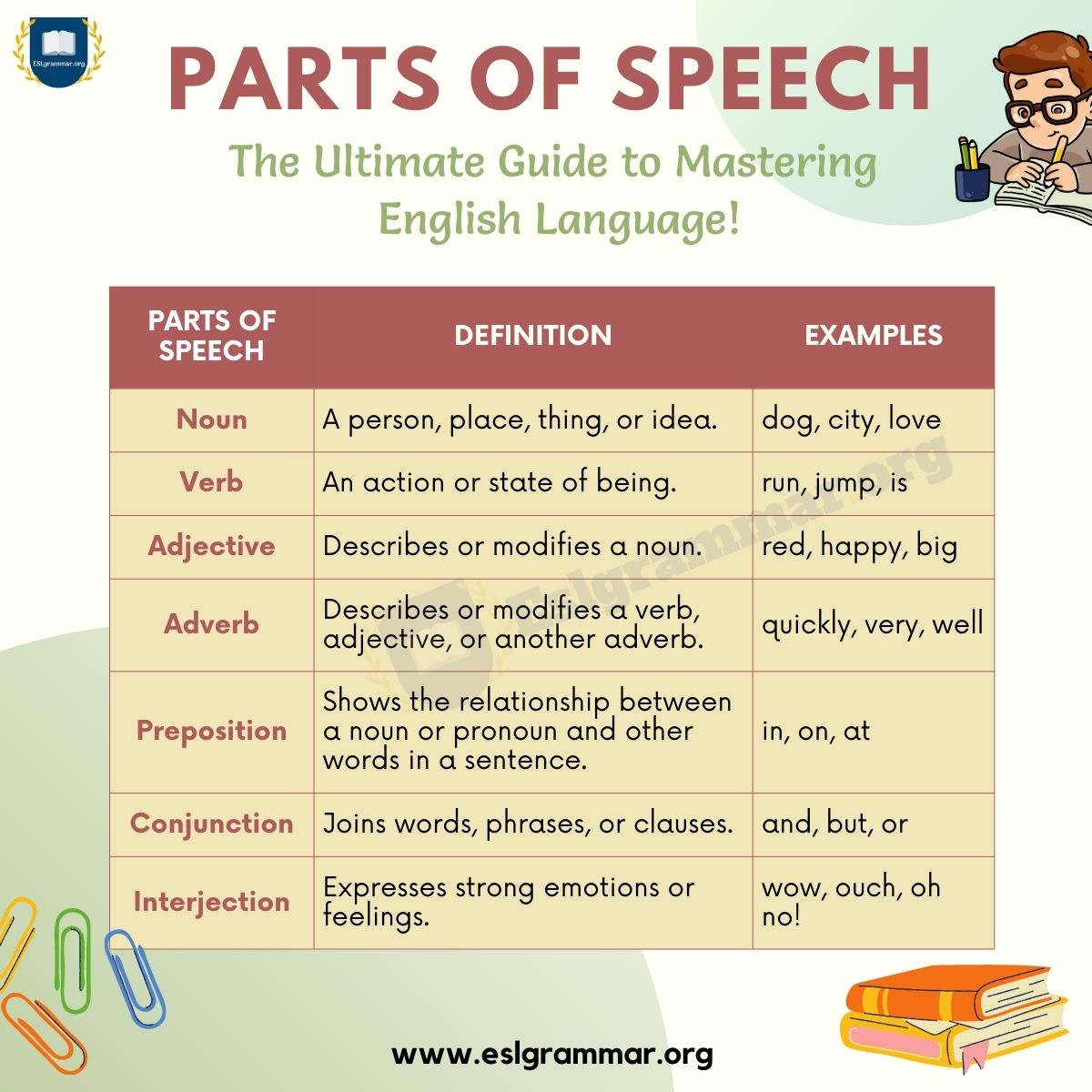
Nouns are words that denote a person, place, or thing. In a sentence, nouns answer the questions who and what. For example, in the sentence “The dog ran after the ball,” there are two nouns: “dog” and “ball.” Nouns can be further classified into common nouns, proper nouns, and collective nouns.
- Common nouns: general names for people, places, or things (e.g., dog, city)
- Proper nouns : specific names of a particular person, place, or thing (e.g., John, London)
- Collective nouns: names for groups of things (e.g., flock, team)
2. Pronouns
Pronouns are words that replace nouns in a sentence. They help avoid repetition and make sentences less monotonous. For example, in the sentence “She gave her book to him,” the pronouns “she,” “her,” and “him” replace the respective nouns. Pronouns can be classified as:
- Personal pronouns : I, you, he, she
- Demonstrative pronouns : this, that, these, those
- Possessive pronouns: mine, yours, his, hers
- Reflexive pronouns: myself, yourself, himself, herself
3. Adjectives
Adjectives are words that describe or modify nouns or pronouns. They provide additional information about the noun/pronoun, such as size, color, or emotion. For example, in the sentence “The red ball is big,” “red” and “big” are adjectives.
Verbs are words that express an action, occurrence, or state of being. They usually indicate what the subject (noun or pronoun) of the sentence is doing. For example, in the sentence “The dog barks,” “barks” is the verb. Verbs can be classified as:
- Action verbs: run, jump, eat, think
- Linking verbs : be, seem, become, appear
- Helping/auxiliary verbs : have, do, will, should
Adverbs are words that modify or describe verbs, adjectives, or other adverbs. They provide additional information about the action or quality of an action, such as how, when, or where it took place. For example, in the sentence “The dog barks loudly,” “loudly” is an adverb.
6. Prepositions
Prepositions are words that show the relationship between a noun or a pronoun and other words in a sentence. They usually indicate direction, location, or time. Common prepositions include:
- Direction : to, from, across, through, towards
- Location : in, on, at, under, above
- Time : before, after, during, since, until
7. Conjunctions
Conjunctions are words that connect words or groups of words in sentences. They help form complex sentences and provide a flow of ideas. There are three main types of conjunctions:
- Coordinating conjunctions : and, but, or, for, so (connect words, phrases, or clauses of equal importance)
- Subordinating conjunctions : because, if, although, when (introduce dependent clauses)
- Correlative conjunctions : either…or, neither…nor, both…and (work in pairs to connect similar elements)
8. Interjections
Interjections are short, abrupt words or phrases that express strong emotion or surprise. They are usually set apart from the rest of the sentence by punctuation, such as an exclamation mark or a comma. Examples of interjections include:
- Surprise: oh, wow, ouch
- Agreement: yes, indeed, exactly
- Disagreement: no, nonsense, definitely not
9. Articles
Articles are a type of determiner that precede nouns to specify the noun’s definiteness (whether it is specific or general) and can be classified as:
- Definite article: the (refers to a specific noun)
- Indefinite articles : a, an (refers to a non-specific noun)
Sentence Examples for the 8 Parts of Speech
In this section, we will provide examples of sentences that illustrate the 8 parts of speech in English. The parts of speech include nouns, pronouns, verbs, adjectives, adverbs, prepositions, conjunctions, and interjections.
| Parts of Speech | Examples |
|---|---|
| Dog | The chased the mailman down the street. |
| Books | Sarah loves reading in the library. |
| She | decided to take up swimming lessons. |
| They | went to the movies together. |
| Jumps | The cat onto the couch. |
| Is | Helen an excellent musician. |
| Happy | The child played with the new toy. |
| Beautiful | She wore a dress to the event. |
| Quickly | The car sped down the road. |
| Softly | She spoke during the presentation. |
| On | The pen is the table. |
| Through | She walked the park. |
| And | She likes pizza pasta. |
| But | I want to go for a run, it’s raining outside. |
| Ouch | That hurt. |
| Wow | What an incredible view. |
Word Classes and Categories
Parts of speech in a language can be subcategorized into word classes and categories, making it easier to study and understand grammar. Word classes can be defined as groups of words that share similar linguistic properties, while categories refer to the roles they play in sentences.
There are generally two basic types of word classes: open and closed. Open word classes are the ones that regularly acquire new words as the language evolves. These include nouns, adjectives, adverbs, and verbs. On the other hand, closed word classes comprise pronouns, prepositions, conjunctions, articles/determiners, and interjections. Closed classes usually remain constant over time, with new words being infrequent additions.
Some major word class categories are:
- Nouns : These represent people, places, things, or ideas. Examples include “dog,” “city,” and “happiness.”
- Verbs : These express actions, states, or occurrences. Examples include “run,” “is,” and “become.”
- Adjectives : These describe qualities or characteristics of nouns. Examples include “tall,” “red,” and “happy.”
- Adverbs : These modify verbs, adjectives, or other adverbs. Examples include “quickly,” “very,” and “well.”
Word classes can be further divided into subcategories based on their specific functions or forms. For instance, nouns can be categorized as proper nouns (e.g., “John”) or common nouns (e.g., “man”), while verbs can be classified as transitive (e.g., “eat”) or intransitive (e.g., “sleep”).
Dictionaries play a crucial role in defining word classes by providing definitions, grammatical information, and usage examples for each word. It helps users understand which category a word belongs to and how it functions in a sentence.
English Language Grammar and Structure
Sentence structure.
In the English language, the foundation of grammar lies in the structure of sentences. A sentence consists of words arranged in a specific order, following a set of rules to convey a complete thought. The basic structure of an English sentence consists of a subject, a verb, and an object. For example:
Furthermore, sentences can be simple, compound, or complex, depending on the number of independent and dependent clauses they contain.
Parts of Speech Relationships
English grammar can be broken down into eight primary parts of speech, each with a unique function in the structure of sentences. These parts of speech are as follows:
- Nouns : They represent people, animals, things, or ideas. Examples: dog, city, love, time.
- Pronouns : These words replace nouns to avoid repetition, such as he, she, they, it, and their.
- Verbs : They describe actions, states, or occurrences, like eat, think, and know.
- Adjectives : Adjectives modify nouns or pronouns, providing more details or descriptions, for instance, red, happy, or large.
- Adverbs : They modify verbs, adjectives, or other adverbs, giving more information about the manner, place, time, or degree. Examples: quickly, very, well.
- Prepositions : These words show the relationship between a noun or pronoun and other words in a sentence, including location or time. Examples: in, on, at, between.
- Conjunctions : They connect words, phrases, or clauses, providing coherence and fluency to sentences. Examples: and, but, because, although.
- Interjections : They express emotions or reactions, often followed by an exclamation point. Examples: oh, wow, ouch, great.
Frequently Asked Questions on Parts of Speech
What are the parts of speech.
The parts of speech are different categories of words based on their usage and role in a sentence. In the English language, there are eight traditional parts of speech: nouns, pronouns, verbs, adjectives, adverbs, prepositions, conjunctions, and interjections.
Can you provide examples of each part of speech?
Certainly! Here are examples for each part of speech:
- Nouns : cat, book, happiness, city
- Pronouns : he, she, they, whose
- Verbs : run, think, be, have
- Adjectives : happy, large, warm, yellow
- Adverbs : quickly, very, almost, gently
- Prepositions : in, on, of, with
- Conjunctions : and, but, or, yet
- Interjections : ouch, hooray, wow, oh
So interesting page
I love this , let me know can we connect
- Parts of Speech
- Sentence Structure
- Sentence Types
- Rules & Usage
- Punctuation
- How to Diagram
- Diagramming Index
- Diagramming Together
- Contact & FAQ
- Stream the Documentary
- Testimonials
Download your free grammar guide here.
What are the parts of speech?
Today's the day for you to learn about this important grammatical concept! But first...let's see what the parts of speech have to do with your clothes.
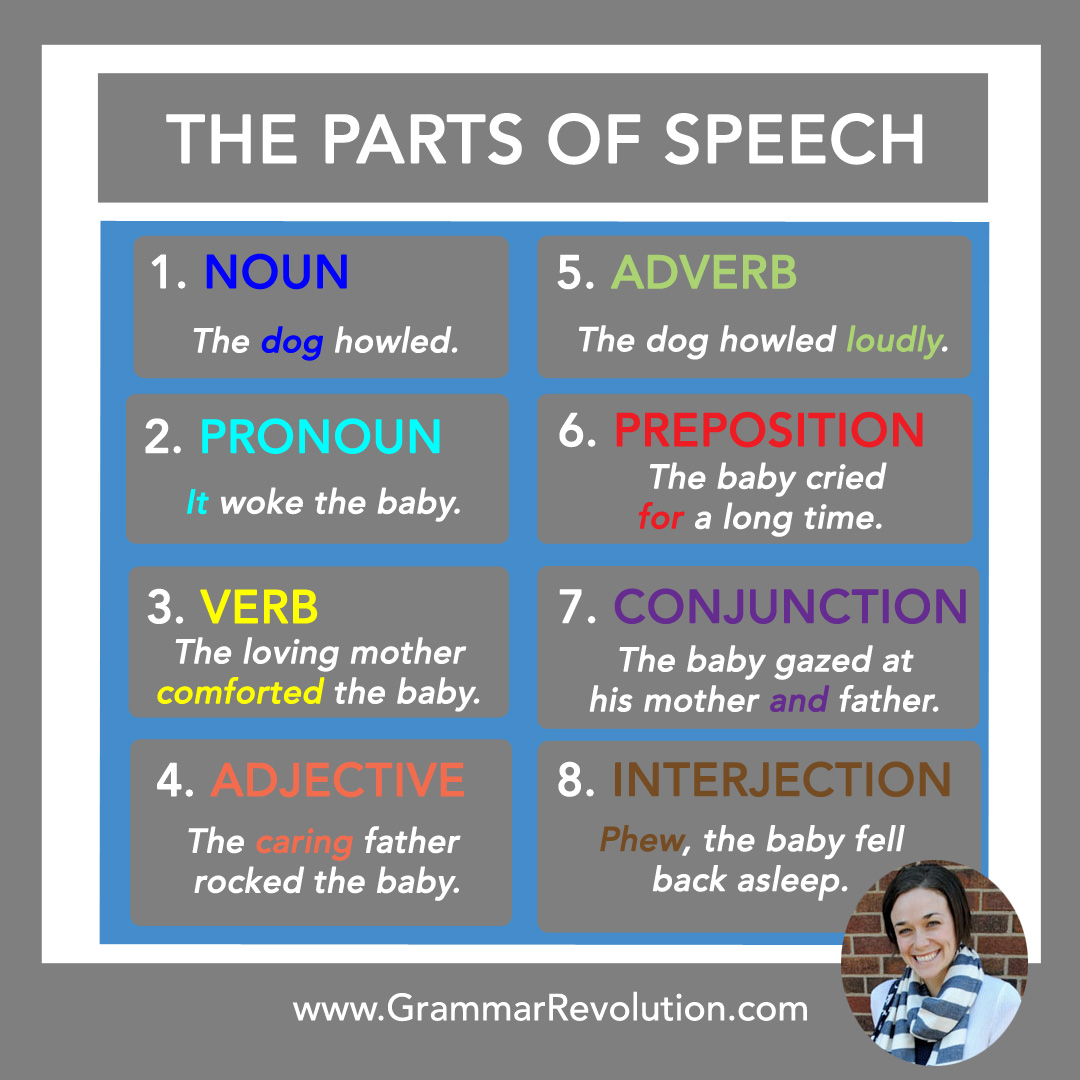
Imagine that it's laundry day, and you've just finished washing and drying your clothes. You dump the contents of the laundry basket onto your bed, and you begin to organize everything. You fold matching socks together, you create a pile of perfectly folded shirts that you would be proud to show Marie Kondo, and you do the same thing with your pants, jackets, and everything else.
In the same way that we organize our clothes into groups based on each item's function and features, we organize our words into categories based on each word's function and features. We call these categories of words the parts of speech .
Some people categorize words into eight parts of speech, and some people categorize them into nine parts of speech. Neither one is wrong; they're just two ways of looking at things. We'll go over these categories below. Here at English Grammar Revolution, we categorize words into eight groups, but I'll tell you about the ninth one as well.
There's one important thing for you to know before we look at these categories: most words can function as more than one part of speech . They will only do one job at a time, but they can do different things in different sentences. Look at the word love in the following sentences.
My love of grammar inspired me to make this website.
Here, love is functioning as a noun. It's the subject of the sentence.
I love you.
Now, love is acting as a verb ! It's telling us an action.
The only way we can know how to categorize a word is to look at how it's acting within a sentence.
Okay, let's check out the parts of speech!
The 8 Parts of Speech
Nouns name people, places, things, or ideas. They're important parts of our sentences because they perform important jobs (subjects, direct objects, predicate nouns, etc.).
A peacock walked through our yard .
The dog howled during the night , and it woke up our whole family .
Sometimes people get bogged down with this part of speech because there are also many subcategories of nouns. This is similar to the way that we have subcategories for our clothes. You may have a whole drawer full of pants, but you may also have different types of pants that you use for different purposes (workout pants, lounge pants, work pants, etc.). This is similar to the way that we can further categorize nouns into smaller groups.
Here are a few of the subcategories of nouns: proper nouns, common nouns , collective nouns , possessive nouns , and compound nouns.
Tip : Other parts of speech also have subcategories. If you're studying this information for the first time, ignore the subcategories and focus on learning about each broader category.
2. Pronouns
Pronouns take the place of nouns. When most people hear the word pronoun , they think of words like I, we, me, he, she, and they . These are indeed all pronouns, but they're a part of a subcategory called personal pronouns. Know that there are other kinds of pronouns out there as well. Here are some examples: myself, his, someone , and who .
Here are a few of the subcategories of pronouns: reflexive pronouns , indefinite pronouns , possessive pronouns , and relative pronouns .
When we walked across the bridge, we saw someone who knows you .
I will fix the dishwasher myself .
Verbs show actions or states of being. They are integral elements of sentences .
The shuttle will fly into space.
The loving mother comforted and soothed the baby.
In the Montessori tradition of education, they use a large red circle or ball to symbolize a verb, and they often teach children to think of verbs as a sun providing the energy of a sentence. Isn't that a lovely way to think of verbs?
I know that you're getting tired of hearing about subcategories, but linking verbs, action verbs, and helping verbs are described on the verb page here .
Modal verbs are described on that link, and you can learn even more about action verbs and linking verbs from those links.
4. Adjectives
Adjectives describe, or modify , nouns and pronouns. I like to think of them as adding color to language. It would be hard to describe a beautiful sunset or the way a touching story makes us feel without using adjectives.
The wise, handsome owl had orange eyes.
The caring father rocked the baby.
One helpful strategy for learning about and identifying adjectives is to learn how they are diagrammed . Sentence diagrams are pictures of sentences that help us see how all of the words are grammatically related. Since adjectives modify nouns and pronouns, we diagram them on slanted lines under the nouns/pronouns that they are modifying.
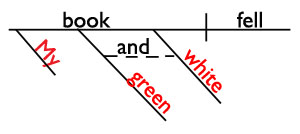
My green and white book fell.
Book is a noun. It's the subject of this sentence. My, green , and white are all adjectives describing book , so we diagram them on slanted lines underneath book . Isn't that a great way to SEE what adjectives do?
Nine Parts of Speech
When people categorize words into eight parts of speech, they say that articles/determiners ( a, an, the, this, that, etc. ) are subcategories of adjectives.
When people categorize words into nine parts of speech, they say that articles/determiners make up their own category and are not a part of the adjective category.
Adverbs modify (describe) verbs, adjectives, and other adverbs. Adverbs are similar to adjectives in that they both modify things.
The extremely cute koala hugged its mom very tightly .
The dog howled loudly .
Sentence diagrams also make it really easy to see what adverbs do. Take a look at this diagram. What do you notice about the way the adverbs are diagrammed?
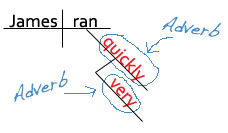
James ran very quickly.
Did you notice that the adverbs are diagrammed on slanted lines under the words that they are modifying?
Ran is a verb. Quickly is an adverb telling us more about the verb ran . Very is an adverb telling us more about the adverb quickly .
Doesn't the diagram make it easier to SEE what adverbs do?
6. Prepositions
Prepositions are probably the most difficult part of speech to explain, but people generally have an easier time understanding them when they look at lots of examples. So...let's start with some examples of commonly used prepositions!
in, for, of, off, if, until
The frog sat in the flower.
The baby cried for a long time.
I'm so convinced that memorizing some of the prepositions will be helpful to you that I'll teach you a preposition song .
Okay, now that we've looked at some examples, let's look at the definition of a preposition.
Prepositions show the relationship between a noun or a pronoun and some other word in the rest of the sentence.
Sentence diagrams will come to the rescue again to help us visualize what prepositions do. Think of prepositions as "noun hooks" or "noun bridges." In the diagram below, notice how the preposition down links the noun tree to the rest of the sentence.
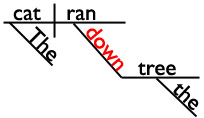
The cat ran down the tree.
Since prepositions always function as "noun hooks," they'll always be accompanied by a noun. The preposition plus its noun is called a prepositional phrase .
If you find a word from the preposition list that's not a part of a prepositional phrase, it's not functioning as a preposition. (You remember that words can function as different parts of speech , right?)
7. Conjunctions
Conjunctions join things together. They can join words or groups of words (phrases and clauses).
The hummingbird sat and waited .
The conjunction and is joining the words sat and waited .
Do you live near the park or near the hospital ?
The conjunction or is joining the phrases near the park and near the hospital.
The two conjunctions we just looked at ( and and or ) belong to a subcategory called coordinating conjunctions, but there are other subcategories of conjunctions as well. The other one that we use most often is subordinating conjunctions . Subordinating conjunctions are a little trickier to learn because they involve a more complicated concept ( dependent adverb clauses ).
For now, just know that all conjunctions, no matter what type they are, connect things together. In fact, let's LOOK at how they do this by looking at a sentence diagram.
Here is a sentence diagram showing how the coordinating conjunction and connects two clauses.
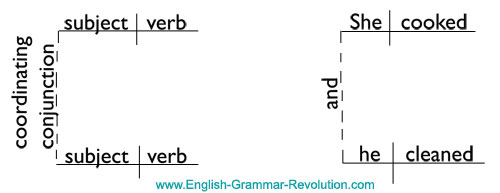
She cooked, and he cleaned.
8. Interjections
Interjections show excitement or emotion.
Wow ! That jump was amazing!
Phew , the baby finally fell asleep.
They are different from the other parts of speech in that they're not grammatically related to the rest of the sentence, and the way that we diagram them reflects that. Look at how we diagram interjections :
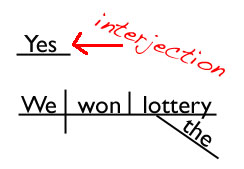
Yes ! We won the lottery!
The interjection yes sit sits there on its own line floating above the rest of the sentence. This helps show that it's not grammatically related to the other words in the sentence.
It's time to review what we covered on this page.
- We can categorize the words that we use into groups based on their functions and features. We call these groups the parts of speech.
- Many words can function as multiple parts of speech. You need to look at each word in the context of a sentence in order to say what part of speech it is.
- The eight parts of speech are nouns, pronouns, adjectives, verbs, adverbs, conjunctions, prepositions, and interjections.
- You just learned about all of the parts of speech. Give yourself a high five!
If you'd like to teach or learn grammar the easy way—with sentence diagrams—check out our Get Smart Grammar Program .
It starts from the very beginning and teaches you grammar and sentence diagramming in easy, bite-size lessons.
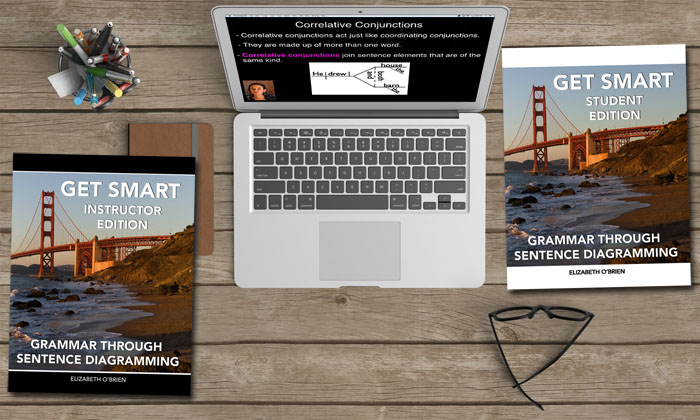
Hello! I'm Elizabeth O'Brien, and my goal is to get you jazzed about grammar.
This is original content from https://www.english-grammar-revolution.com/parts-of-speech.html
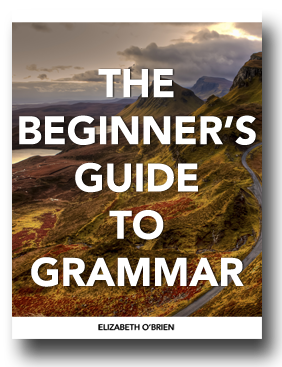
Our Free Guide Gives You A Fun Way
To Teach And Learn The Basics v

Elizabeth O'Brien is the creator of Grammar Revolution.
Her lessons are guaranteed to give you more confidence in your communication skills and make you smile. :)
Other Helpful Resources
- Learn more about how Montessori classrooms teach the parts of speech .
Sentences & Diagrams
Shop & log in.
|
|
|
|
Home BLOG SHOP Contact PRIVACY POLICY Your Purchases
Copyright © 2009 - 2024 Grammar Revolution. All Rights Reserved.
JOIN OUR PRIVATE FACEBOOK GROUP RSS INSTAGRAM
Parts of Speech
Perfect english grammar.

- Noun (apple, table, book, beauty, sky, life)
- Verb (be, want, go, do, imagine)

Hello! I'm Seonaid! I'm here to help you understand grammar and speak correct, fluent English.

The 8 Parts of Speech in English Grammar

Table of Contents
Introduction, what are parts of speech, a list of 8 parts of speech, prepositions, conjunctions, interjections, analyzing sentence structure (parts of speech) , how many parts of speech are used in english, are there 9 parts of speech, are articles and determiners parts of speech, how do you identify parts of speech in a sentence.
- Page Content
- Sidebar Content
- Main Navigation
- Quick links
- All TIP Sheets
The Eight Parts of Speech
- Prepositions
- Conjunctions
- Interjections
- Basic Sentence Structure
- Sentence Fragments
- Run-on Sentences and Comma Splices
- Sentence Type and Purpose
- Independent and Dependent Clauses: Coordination and Subordination
- Subject Verb Agreement
- Consistent Verb Tense
- Other Phrases: Verbal, Appositive, Absolute
- Pronoun Reference
- Relative Pronouns: Restrictive and Nonrestrictive Clauses
- Avoiding Modifier Problems
- Transitions
- Would, Should, Could
- Achieving Parallelism
- Definite and Indefinite Articles
- Two-Word Verbs
TIP Sheet THE EIGHT PARTS OF SPEECH
There are eight parts of speech in the English language: noun, pronoun, verb, adjective, adverb, preposition, conjunction, and interjection. The part of speech indicates how the word functions in meaning as well as grammatically within the sentence. An individual word can function as more than one part of speech when used in different circumstances. Understanding parts of speech is essential for determining the correct definition of a word when using the dictionary.
1. NOUN
- A noun is the name of a person, place, thing, or idea.
man... Butte College... house... happiness
A noun is a word for a person, place, thing, or idea. Nouns are often used with an article ( the , a , an ), but not always. Proper nouns always start with a capital letter; common nouns do not. Nouns can be singular or plural, concrete or abstract. Nouns show possession by adding 's . Nouns can function in different roles within a sentence; for example, a noun can be a subject, direct object, indirect object, subject complement, or object of a preposition.
The young girl brought me a very long letter from the teacher , and then she quickly disappeared. Oh my!
See the TIP Sheet on "Nouns" for further information.
2. PRONOUN
- A pronoun is a word used in place of a noun.
She... we... they... it
A pronoun is a word used in place of a noun. A pronoun is usually substituted for a specific noun, which is called its antecedent. In the sentence above, the antecedent for the pronoun she is the girl. Pronouns are further defined by type: personal pronouns refer to specific persons or things; possessive pronouns indicate ownership; reflexive pronouns are used to emphasize another noun or pronoun; relative pronouns introduce a subordinate clause; and demonstrative pronouns identify, point to, or refer to nouns.
The young girl brought me a very long letter from the teacher, and then she quickly disappeared. Oh my!
See the TIP Sheet on "Pronouns" for further information.
3. VERB
- A verb expresses action or being.
jump... is... write... become
The verb in a sentence expresses action or being. There is a main verb and sometimes one or more helping verbs. (" She can sing." Sing is the main verb; can is the helping verb.) A verb must agree with its subject in number (both are singular or both are plural). Verbs also take different forms to express tense.
The young girl brought me a very long letter from the teacher, and then she quickly disappeared . Oh my!
See the TIP Sheet on "Verbs" for more information.
4. ADJECTIVE
- An adjective modifies or describes a noun or pronoun.
pretty... old... blue... smart
An adjective is a word used to modify or describe a noun or a pronoun. It usually answers the question of which one, what kind, or how many. (Articles [a, an, the] are usually classified as adjectives.)
See the TIP Sheet on "Adjectives" for more information.
5. ADVERB
- An adverb modifies or describes a verb, an adjective, or another adverb.
gently... extremely... carefully... well
An adverb describes or modifies a verb, an adjective, or another adverb, but never a noun. It usually answers the questions of when, where, how, why, under what conditions, or to what degree. Adverbs often end in -ly.
See the TIP Sheet on "Adverbs" for more information.
6. PREPOSITION
- A preposition is a word placed before a noun or pronoun to form a phrase modifying another word in the sentence.
by... with.... about... until
(by the tree, with our friends, about the book, until tomorrow)
A preposition is a word placed before a noun or pronoun to form a phrase modifying another word in the sentence. Therefore a preposition is always part of a prepositional phrase. The prepositional phrase almost always functions as an adjective or as an adverb. The following list includes the most common prepositions:
See the TIP Sheet on "Prepositions" for more information.
7. CONJUNCTION
- A conjunction joins words, phrases, or clauses.
and... but... or... while... because
A conjunction joins words, phrases, or clauses, and indicates the relationship between the elements joined. Coordinating conjunctions connect grammatically equal elements: and, but, or, nor, for, so, yet. Subordinating conjunctions connect clauses that are not equal: because, although, while, since, etc. There are other types of conjunctions as well.
The young girl brought me a very long letter from the teacher, and then she quickly disappeared. Oh my!
See the TIP Sheet on "Conjunctions" for more information.
8. INTERJECTION
- An interjection is a word used to express emotion.
Oh!... Wow!... Oops!
An interjection is a word used to express emotion. It is often followed by an exclamation point.
The young girl brought me a very long letter from the teacher, and then she quickly disappeared. Oh my !
See the TIP Sheet on "Interjections" for more information.
Home | Calendars | Library | Bookstore | Directory | Apply Now | Search for Classes | Register | Online Classes | MyBC Portal MyBC -->
Butte College | 3536 Butte Campus Drive, Oroville CA 95965 | General Information (530) 895-2511

Parts of Speech in English
Parts of speech are categories of words that perform similar grammatical roles in phrase and sentence structures. You might wonder what the different parts of speech are and how to identify them. This reference explains parts of speech, including nouns, verbs, pronouns, adjectives, adverbs, determiners, conjunctions, prepositions, and interjections, with examples.
You’ll also learn about open and closed word classes, how to determine a part of speech in a sentence, and their roles in simple and complex sentence constructions. This guide includes a useful picture, a video, and a quiz on parts of speech to help solidify your understanding.
Parts of Speech

What Are Parts Of Speech?
Parts of speech are word categories defined by their roles in sentence structures. These categories are organized by the functions and meanings they convey. In English, there are around ten common parts of speech: nouns , verbs , adjectives , adverbs , pronouns , prepositions , conjunctions , interjections , determiners , and articles .
Open and Closed Word Classes
Closed word classes are parts of speech that do not have newer words introduced over time. These include pronouns, conjunctions, determiners, and prepositions.
Open word classes are parts of speech that can have newer words introduced over time. These include nouns, verbs, adjectives, interjections, and adverbs.
Different Parts of Speech (with Examples)
The noun (n.).
A noun gives a name to something. There are different types of nouns like proper, collective, possessive, and common nouns.
Jeffrey, Korea, pen, New Year, dog, cat, elephant, garden, school, work, music, town, Manila, teacher, farmer, Bob, Sean, Michael, police officer, France, coffee, football, danger, happiness…
Example sentences:
- The teacher told the children to stop chattering in class.
- John is good at French but weak at History .
Common Noun : Names a general item.
- Here is a cup .
- Do you want a cake ?
Proper Noun: Names a specific item.
- The capital of England is London .
- Sarah is beautiful.
Collective Noun: Refers to a group.
- The swarm of bees was headed straight towards our picnic.
- At church on Sunday, the choir sings loudly.
Possessive Noun: Shows ownership.
- This is my dog’s ball.
- That is Sarah’s friend.
The Verb (v.)
A verb describes an action. There are three main types: action, linking, and modal verbs.
Walk, is, seem, realize, run, see, swim, stand, go, have, get, promise, invite, listen, sing, sit, laugh, walk…
- Don’t try to run before you can walk .
- Did you kiss anybody?
- Leave me alone!
Action Verb : Describes an action.
- The man walked down the street.
- I laughed at his joke.
- She ran to catch the bus before it left.
- The chef chopped the vegetables into small pieces for the salad.
Linking Verb: Connects the subject to a noun, adjective, or pronoun.
- Sarah feels cold.
- I am very tired.
- The flowers in the garden are blooming beautifully in the spring.
- The soup smells delicious and makes my mouth water.
Modal Verb: Helps the main verb and shows the speaker’s thoughts.
- I might walk to the park this afternoon.
- He can eat the last slice of cake.
- You must listen to me!
The Pronoun (pron.)
A pronoun replaces a noun. There are various types of pronouns like reflexive, indefinite, possessive, and relative pronouns.
I, me, we, you, he, she, yours, himself, its, my, that, this, those, us, who, whom
- Richard isn’t at work this week; he ‘s gone on holiday.
- Don’t tell her the truth.
- She tried it herself .
- You can’t blame him for everything .
- The woman who called yesterday wants to buy the house.
Reflexive Pronoun: Refers to self.
- I am going to keep this last cupcake for myself .
- Peter always puts himself first.
Indefinite Pronoun: Refers to a non-specific person or item.
- Can you take all ?
- I need to speak to someone about this rash on my arm.
Possessive Pronoun: Shows ownership.
- This bag is not yours , it’s mine .
- Her book is so new, while his looks vintage.
Relative Pronoun: Introduces an adjective clause.
- This is the woman who will be working with you.
- Is this the book that everyone is raving about?
The Adjective (adj.)
An adjective describes a noun or pronoun.
Beautiful, seven, cute, second, tall, blue, angry, brave, careful, healthy, little, old, generous, red, smart, two, small, tall, some, good, big, useful, interesting…
- This is a blue car.
- The small squirrel ran up the tree.
- During the thunderstorm, we saw some heavy rain.
- My mother has short hair.
- The documentary on TV last night was very interesting .
- My son has an impressive collection of toy soldiers.
- The weather is hot and sunny today.
- My vacation was exciting .
- The leaves on that tree are green and large .
The Adverb (adv.)
An adverb modifies an adjective, verb, or another adverb. Many adverbs end in -ly, but not all do.
Neatly, tomorrow, very, badly, fully, carefully, hardly, nearly, hungrily, never, quickly, silently, well, really, almost…
- This is an extremely attractive photograph.
- I have a very large pet dog.
- My car drives quickly .
- When I am running late for work, I eat my breakfast rapidly .
- The boy is crying loudly .
- She carefully preserved all his letters.
Determiners and Articles
Determiners and articles help clarify the nouns they introduce. Articles can be definite ( the ) or indefinite ( a , an ).
The, a, an, this, that, these, those, many, few, each, every, some, any, no, which, what
- The cat is sleeping on a mat.
- Can an apple be green?
- This book is very interesting.
- Each student must bring their own lunch.
The Conjunction (conj.)
A conjunction connects words, phrases, or clauses. Some common conjunctions are and , but , or , so , because , and although .
And, but, or, so, because, although, if, until, while, since, when, after, before, as
- I want to buy a sandwich and a drink.
- She was tired but happy.
- You can go to the party or stay home.
- They were late because of the traffic.
- Although it was raining, we went for a walk.

The Preposition (prep.)
A preposition shows the relationship of a noun (or pronoun) to another word. Common prepositions include at , on , in , by , with , and about .
At, on, in, by, with, about, above, below, between, during, for, from, over, under, through
- The cat is on the roof.
- She sat by the window.
- We will meet at the park in the afternoon.
- The book is about a boy with a magical power.
The Interjection (interj.)
An interjection is a word or phrase that expresses strong emotion or sudden exclamation. Common interjections include wow , ouch , oh , and hey .
Wow, ouch, oh, hey, ah, ugh, ew, hmm, yay, yikes, whoa, oops, aha, hurray, ew, oh no
- Wow ! That’s amazing!
- Ouch ! That hurt.
- Oh ! I didn’t see you there.
- Hey ! Wait for me.
- Yay ! We won the game.
In this section, you’ve learned about different parts of speech with examples and sample sentences. Each part of speech plays a unique role in creating meaningful sentences.
How To Determine A Part Of Speech In A Sentence
To determine a part of speech in a sentence, look at the word being used, its context, and what meaning it brings to the sentence structure. Here are some questions you can ask about a particular word:
- Is it a person, place, idea, name, or thing? It is a noun .
- Is the word used in place of a noun? It is a pronoun .
- Does the word convey an action, occurrence, or state of being? It is a verb .
- Does the word modify a noun? It is an adjective .
- Does the word modify a verb, adjective, or itself? It is an adverb .
- Is the word placed in front of a noun to form a modifying phrase? It is a preposition .
- Does the word link a phrase or clause? It is a conjunction .
- Is the word a quick expression of emotion? It is an interjection .
- Is the word placed before a noun to clarify it? It is a determiner or an article .
By asking these questions, you can identify the correct part of speech for any word in a sentence.
Parts of Speech and Sentence Construction
Simple/basic sentences.
In its simplest form, a sentence can have one independent clause .
For example, the sentence “I walk to the store” contains one clause.
- “I” is the subject of the clause, while “walk” is the verb.
- The ending phrase, “walk to the store” would be the verb phrase, or predicate , of the sentence.
This entire sentence “I walk to the store” is an independent clause, expresses one subject doing one action — and is known as a simple sentence .
Knowing this, apply the fact that nouns and pronouns will often be the subjects or objects of simple sentences, while verbs will convey actions. So once again:
- I (subject, pronoun)
- walk (verb)
- to (preposition)
- the (article)
- store (object, noun)
Complex Sentences
Complex sentences contain an independent clause and one or more dependent clauses. These sentences use conjunctions such as because, since, which, or who to connect clauses. Consider the structure and an example below:
- Independent Clause: She reads a book
- Dependent Clause: because she wants to learn
By combining these clauses, one forms a complex sentence: She reads a book because she wants to learn.
Other examples of complex sentences:
- Although the weather was cold, they decided to go for a hike.
- She completed her assignment before she went out with her friends.
- When you finish your homework, we can go to the movies.
- Because my coffee was too cold, I heated it in the microwave.
- If you save your money, you can buy a new bicycle.

Parts of Speech Video
Learn all parts of speech in English with a useful video lesson.
Parts Of Speech Quiz
Here are some Parts Of Speech exercises for you to practice:
A. In the sentence “I ran to the tallest tree”, what part of speech is the word “tallest”?
- A preposition
- An adjective
B. In the 2000s, the word staycation described the act of staying home for a vacation. Since “staycation” is a noun and a new word, what class of words does it belong to?
- The Open word class
- The Closed word class
- The Infinitive word class
C. In the sentence “I’ll have a few tacos”, what part of speech is the phrase “a few”?
- Interjections
- Determiners
Answers: A) 3, B) 1, C) 3
- Latest Posts
- Active vs. Passive Voice Exercises – Active vs. Passive Voice Worksheet - December 25, 2023
- Phrase Exercises – Phrase Worksheet - December 23, 2023
- Sentence Exercises – Sentence Worksheet - December 23, 2023
- Phrases and Clauses
- Parts of a Sentence
- Modal Verbs
- Relative Clauses
- Confusing Words
- Online Grammar Quizzes
- Printable Grammar Worksheets
- Courses to purchase
- Grammar Book
- Grammar Blog
The main two parts of a sentence are the subject and predicate , with the subject identifying whom or what the sentence is about and the predicate giving more information about the subject.
The elements within the predicate adding more detail or meaning, are verbs, direct objects, indirect objects, and subject complements.
We'll now look at each of these in more detail.
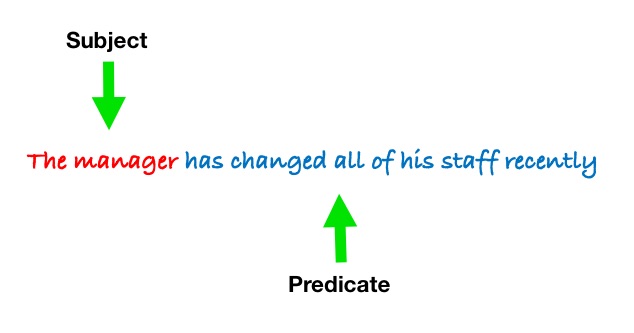
The subject of a sentence is the person, place, or thing that the sentence is about.
If it comes before an action verb (e.g. climb, eat, build, say etc) then it is the part of the sentence that shows whom or what is doing that action. If it comes before a state verb (e.g. is, see, smell) it tells us whom or what is in that state of being.
It is usually a noun or pronoun and can also include modifying words, phrases or clauses. Here are some examples of subjects in a sentence:
- The woman...
- The boy in the red coat ... (includes modifying phrase)
While the subject is what the sentence is about, the predicate is what is being said about the subject.
It will always include a verb but will usually also include other elements. So these are what it will/may include:
Direct Object
- Indirect Object + Direct Object
- Direct Object + Object Complement
Subject Complement
In the examples below, the predicate is in bold.
- The woman is hot.
- Cars are blocking all the parking spaces.
- The boy in the red coat is trying to find his toy.
- She is a police officer.
Predicates as parts of a sentence can get a little more complex than this as there can be predicates within predicates when there are other clauses in the sentence (the ones above have just one clause) and there are also compound predicates.
The predicate always includes and starts with a verb, but it may also be followed by objects.
A direct object is the receiver of the action within a sentence, and it is usually a noun or pronoun. They are used with action verbs and are shown below in bold:
- He built a cottage
- The horse jumped the fence
- He ate some dinner
The complete predicate in this case is " built a cottage " and so on.
Indirect Object
Indirect objects can only be in a sentence if there is also a direct object. They indicate to whom or for whom the action of the sentence is being done. Again, the indirect object is usually a noun or pronoun.
They are shown below in bold (the direct object is now the last noun).
- He built his family a cottage
- She bought them some presents
- He gave his girlfriend a kiss
The complete predicate in this case is " built his family a cottage " and so on.
Learn more about the difference between direct and indirect objects .
Object Complement
Object complements provide more information about or describe the direct object, and they can be nouns or adjectives.
- He built the house shoddily.
- Exciting films make me happy.
- The students elected John as president of the student's union .
So to take the first one, the direct object is 'the house ' and it is being described as ' shoddily built '.
The complete predicate is: "built the house shoddily".
It was explained above that objects are used with action verbs . However, for state verbs (verbs that describe a state of being e.g. is, see, hear, feel etc) subject complements follow the verb.
A subject complement either renames or identifies the subject by including a noun - predicate nominative - or describes the subject by having an adjective - predicate adjective .
- John is a really nice person
- She seems happy
- I was impressed by the film
The complete predicate in this case is " is a really nice person " and so on.
Parts of a Sentence Summary
The parts of a sentence can be divided into two main parts:
- Subject: who or what the sentence is about
- Predicate: what is being said about the subject
The predicate will start with a verb and could have various other elements:
- verb + indirect object/direct object/object complement/subject complement
More on Sentence Structure:
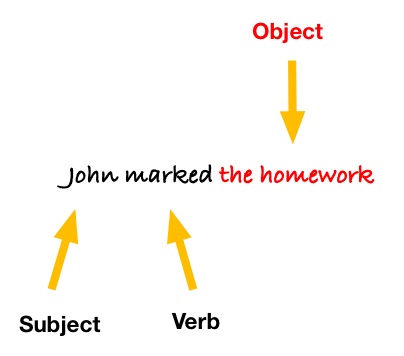
Direct and Indirect Objects: The Differences
Direct and indirect objects are key parts of most sentences. A direct object is the receiver of action while indirect object identifies to or for whom or what the action of the verb is performed.
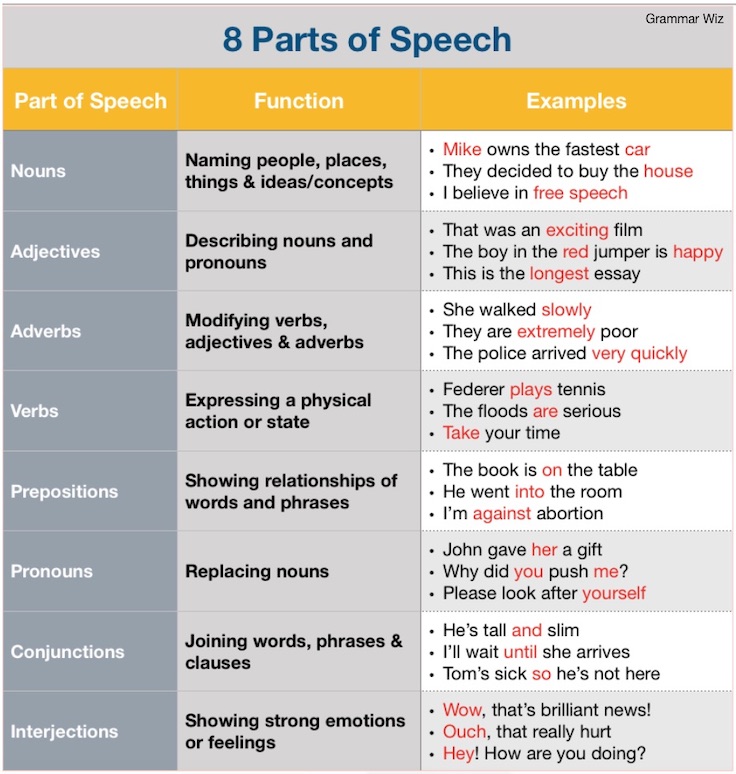
8 Parts of Speech in English Grammar
The 8 parts of speech are Nouns, Adjectives, Adverbs, Verbs, Prepositions, Pronouns, Conjunctions, and Interjections. Learn about the function of each of these grammatical categories.
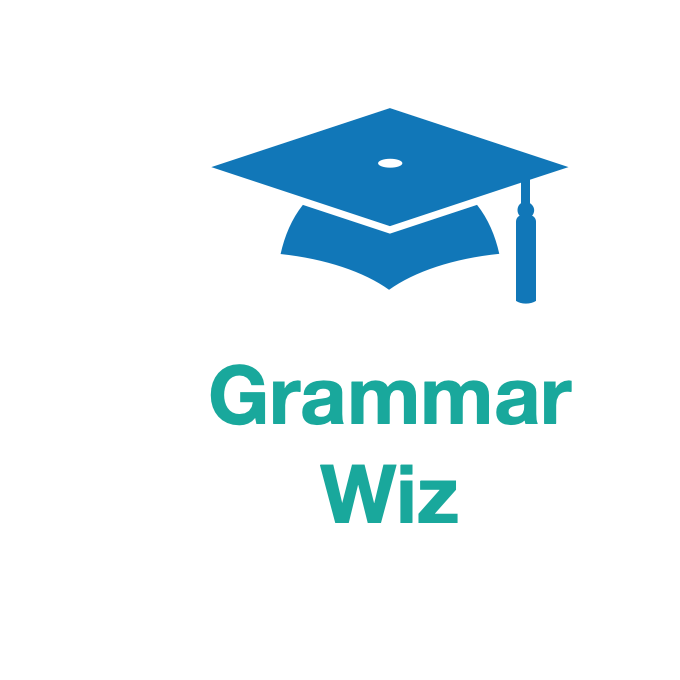
Parallelism Grammar Rules (Parallel Structure)
Parallelism is about balancing the grammatical structure of words, phrases and clauses in your sentences. Parallel structure will improve your writing's coherence.

Examples of Parallelism in English Grammar
View examples of parallelism in English grammar that show you correct and incorrect parallel sentences.

Phrases and Clauses - Building good sentences
Phrases and clauses are the key building blocks of sentences. A clause contains a subject and a verb and can express a complete thought. A phrase does not contain a subject or verb.
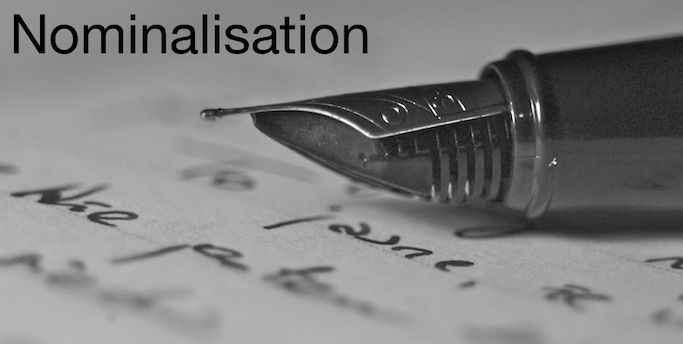
Nominalisation in English Grammar: High Level Writing Tips
Nominalisation is an important aspect of academic writing. This lesson teachers you what this is and how you can use it effectively in your writing.

How to Use Either and Neither with Examples
Advice on how to use either and neither in English grammar. They can be adjectives, adverbs, pronouns and conjunctions.

Subject Complements: Predicate Adjectives and Predicate Nominatives
Here we demystify subject complements, predicate adjectives, and predicate nominatives with simple explanations and examples.

Types of Clauses in English Grammar - Independent and Dependent Clause
The two types of clauses in English grammar are the independent and dependent clause. Both have a subject and verb which makes them clauses, but while independent clauses express a complete thought, dependent clauses do not. This is the main distinction.

Using Object Complements in a Sentence
Using object complements in a sentence enhances your ability to convey specific information about actions and their outcomes.
New! Comments
Any questions or comments about the grammar discussed on this page?
Post your comment here.

Sign up for free grammar tips, quizzes and lessons, straight into your inbox
Grammar Rules
Subscribe to grammar wiz:, grammar ebook.
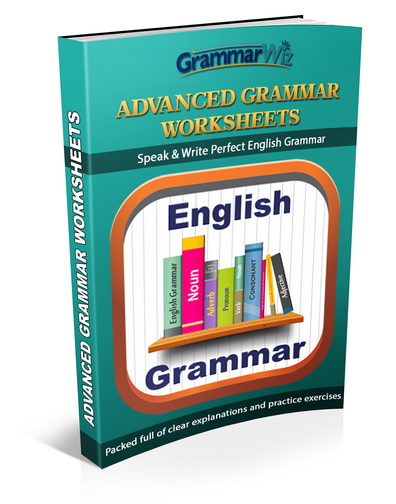
This is an affiliate link
Recent Articles
Classification of prepositions in english: types and examples.
Oct 06, 24 06:43 AM
Prepositions of Manner Quiz
Sep 29, 24 03:06 AM
Prepositions of Location Quiz
Sep 20, 24 05:29 AM
Important Pages
Online Quizzes Grammar Lessons Courses Blog
Connect with Us
Search Site
Privacy Policy / Disclaimer / Terms of Use

Learn English
- Parts of Speech
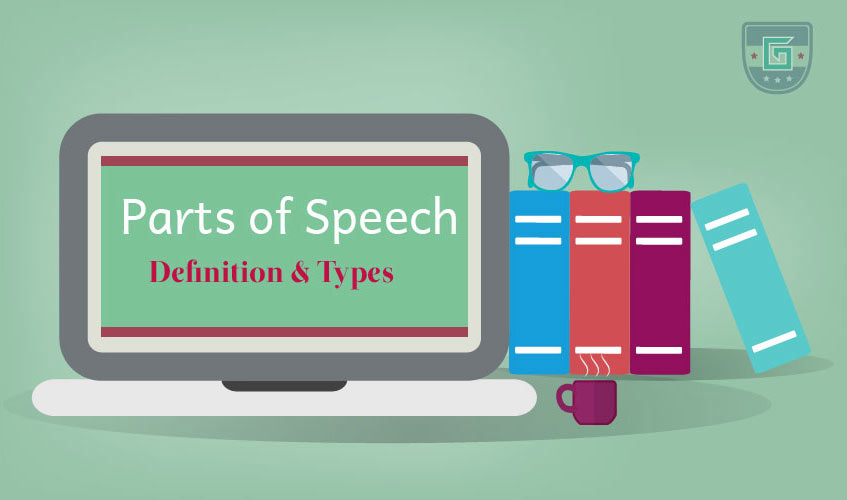
Parts of speech are the classification of words categorized by their roles and functions within the structure of the language.
Parts of speech encompass everything a language has in itself. Can you imagine all the words of a language can be sorted into these categories? They play different roles in the structure of a language. In English, there are eight parts of speech:
- Preposition
- Conjunction
- Interjection
Noun refers to people, places, things, ideas, concepts, etc.
Example: Michael is a good boy. Melbourne is the best city .
A pronoun is used to refer to a noun/noun phrase, or nouns/noun phrases; instead of the repeated use of the same noun(s)/noun phrase(s).
Example: Michael is a good boy. He gets up early in the morning.
Verb shows an action or an ongoing condition. It is considered as the heart of a sentence.
Example: Alex is going home. He loves his home.
Adjective modifies or describes noun in a sentence.
Example: Alex loves his beautiful daughters. His daughters also love their caring father.
Adverbs modify or describe adjectives, verbs, or other adverbs. It answers the questions When? Where? How? or How much?
Example: He is running fast . She always reads attentively .
Preposition gives context to nouns in relationship to other nouns or pronouns.
Example: I am going to France. France is in Europe.
A conjunction connects nouns, noun phrases, clauses or sentences together.
Example: Julie love chocolate and chips. She loves pasta, but she hates pizza.
Interjections are brief and abrupt pauses in speech, usually used for expressing emotions.
Example: Oh! That feels terrible. Alas! They have lost the match.
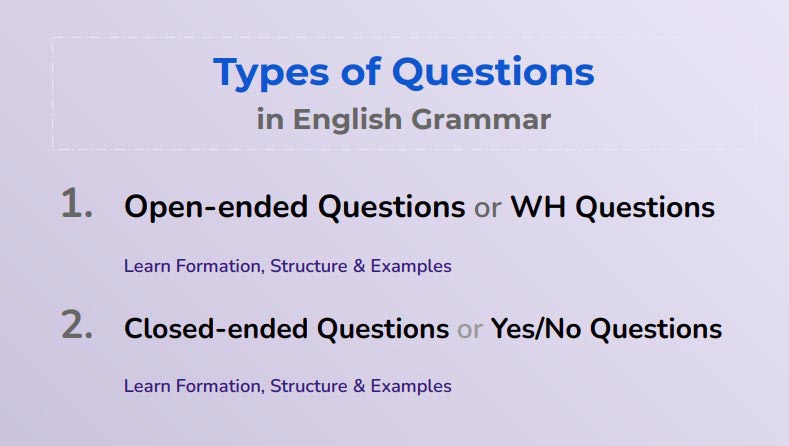
Types of Questions: Open-ended and Closed-ended
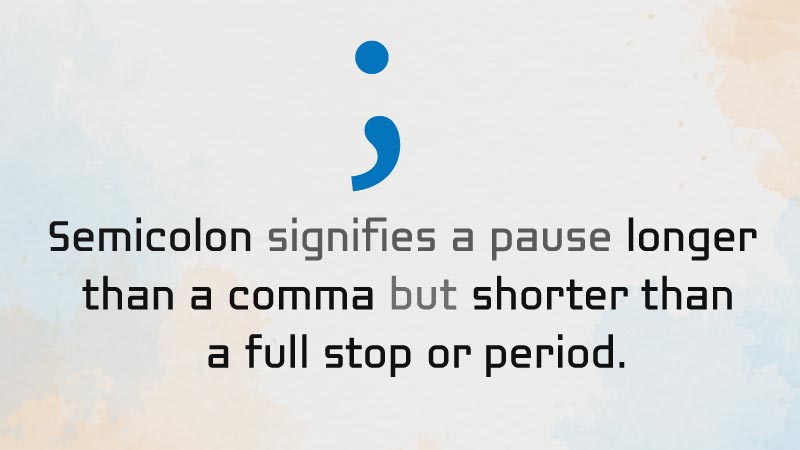
Correct Use of Semicolons
Uses of direct & indirect object, correct use of "sequence of tense" in writing, antecedents of pronoun.
- Conditionals
- How to Use "Therefore" in Sentences Avoiding Common Mistakes
- How to Use "Whereas" with Examples and Avoid Common Mistakes
- When and How to Use "Thus" Correctly Without Common Mistakes
- How to Use "On the Contrary" Properly with Meaning and Examples
- When and How to Use "Either/Or" with Examples and Common Mistakes to Avoid
- How to Use "On the Other Hand" Effectively without Mistakes
- How to Use "Respectively" with Example and Common Errors to Avoid
- How and When to Use "Moreover" Without Mistakes
- How to Use "Likewise" in Sentences Based on Context & When not to Use
- When & How to Use "Although" in Sentences to Avoid Mistake

Parts of Speech: The Ultimate Guide for Students and Teachers
This article is part of the ultimate guide to language for teachers and students. Click the buttons below to view these.
What are Parts of Speech ?
Just as a skilled bricklayer must get to grips with the trowel, brick hammer, tape measure, and spirit level, the student-writer must develop a thorough understanding of the tools of their trade too.
In English, words can be categorized according to their common syntactic function in a sentence, i.e. the job they perform.
We call these different categories Parts of Speech . Understanding the various parts of speech and how they work has several compelling benefits for our students.
Without first acquiring a firm grasp of the various parts of speech, students will struggle to fully comprehend how language works. This is essential not only for the development of their reading comprehension but their writing skills too.

Parts of speech are the core building blocks of grammar . To understand how a language works at a sentence and a whole-text level, we must first master parts of speech.
In English, we can identify eight of these individual parts of speech, and these will provide the focus for our Complete Guide to Parts of Speech .
THE EIGHT PARTS OF SPEECH (Click to jump to each section)
A complete unit on teaching figurative language.
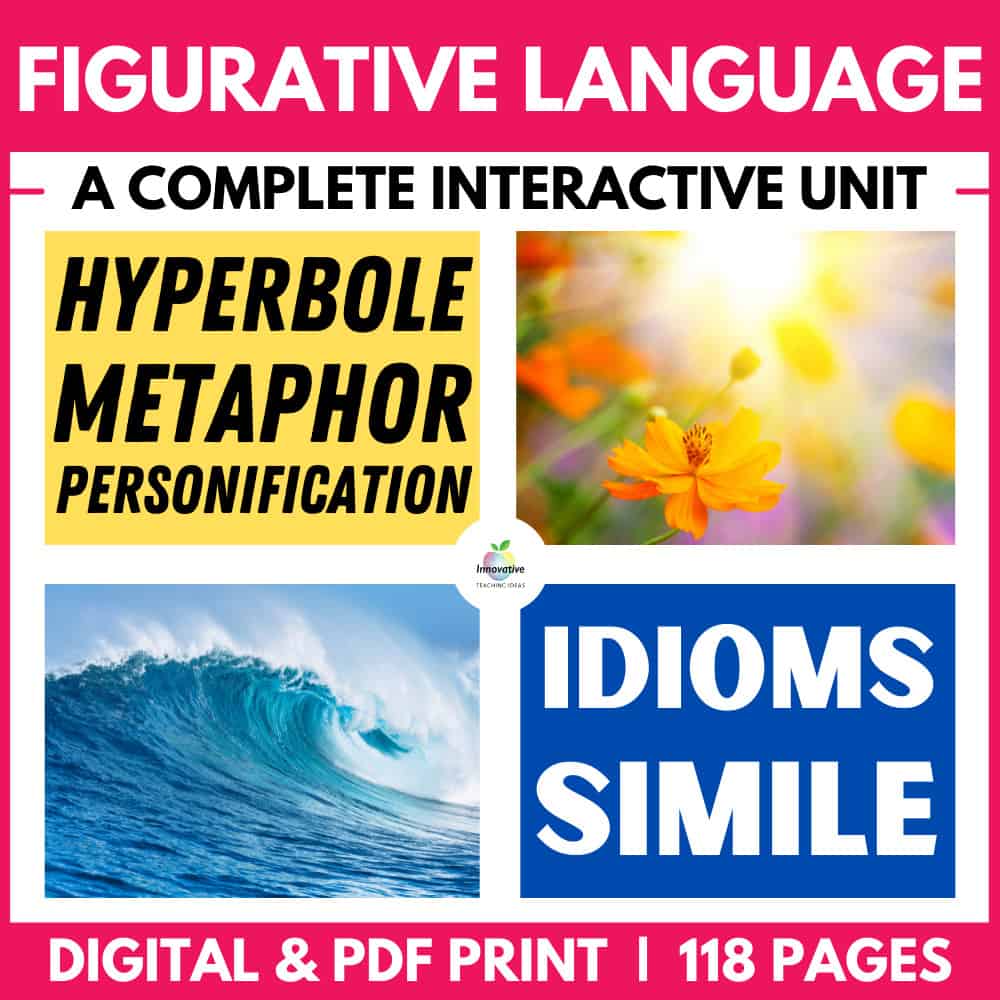
FIGURATIVE LANGUAGE is like “SPECIAL EFFECTS FOR AUTHORS.” It is a powerful tool to create VIVID IMAGERY through words. This HUGE UNIT guides you through completely understanding FIGURATIVE LANGUAGE .
⭐⭐⭐⭐⭐ (26 Reviews)

Often the first word a child speaks will be a noun, for example, Mum , Dad , cow , dog , etc.
Nouns are naming words, and, as most school kids can recite, they are the names of people, places, and things . But, what isn’t as widely understood by many of our students is that nouns can be further classified into more specific categories.
These categories are:
Common Nouns
Proper nouns, concrete nouns, abstract nouns, collective nouns, countable nouns, uncountable nouns.
All nouns can be classified as either common or proper .
Common nouns are the general names of people, places, and things. They are groups or classes on their own, rather than specific types of people, places, or things such as we find in proper nouns.
Common nouns can be further classified as abstract or concrete – more on this shortly!
Some examples of common nouns include:
People: teacher, author, engineer, artist, singer.
Places: country, city, town, house, garden.
Things: language, trophy, magazine, movie, book.
Proper nouns are the specific names for people, places, and things. Unlike common nouns, which are always lowercase, proper nouns are capitalized. This makes them easy to identify in a text.
Where possible, using proper nouns in place of common nouns helps bring precision to a student’s writing.
Some examples of proper nouns include:
People: Mrs Casey, J.K. Rowling, Nikola Tesla, Pablo Picasso, Billie Eilish.
Places: Australia, San Francisco, Llandovery, The White House, Gardens of Versailles.
Things: Bulgarian, The World Cup, Rolling Stone, The Lion King, The Hunger Games.
Nouns Teaching Activity: Common vs Proper Nouns
- Provide students with books suitable for their current reading level.
- Instruct students to go through a page or two and identify all the nouns.
- Ask students to sort these nouns into two lists according to whether they are common nouns or proper nouns.
As mentioned, all common and proper nouns can be further classified as either concrete or abstract .
A concrete noun is any noun that can be experienced through one of the five senses. In other words, if you can see, smell, hear, taste, or touch it, then it’s a concrete noun.
Some examples of concrete nouns include:
Abstract nouns refer to those things that can’t be experienced or identified through the five senses.
They are not physical things we can perceive but intangible concepts and ideas, qualities and states.
Some examples of abstract nouns include:
Nouns Teaching Activity: Concrete Vs. Abstract Nouns
- Provide students with a book suitable for their current reading level.
- Instruct students to go through a page or two and identify all the nouns (the lists from Practice Activity #1 may be suitable).
- This time, ask students to sort these nouns into two lists according to whether they are concrete or abstract nouns.
A collective noun is the name of a group of people or things. That is, a collective noun always refers to more than one of something.
Some examples of collective nouns include:
People: a board of directors, a team of football players, a cast of actors, a band of musicians, a class of students.
Places: a range of mountains, a suite of rooms, a union of states, a chain of islands.
Things: a bale of hay, a constellation of stars, a bag of sweets, a school of fish, a flock of seagulls.
Countable nouns are nouns that refer to things that can be counted. They come in two flavors: singular and plural .
In their singular form, countable nouns are often preceded by the article, e.g. a , an , or the .
In their plural form, countable nouns are often preceded by a number. They can also be used in conjunction with quantifiers such as a few and many .
Some examples of countable nouns include:
COUNTABLE NOUNS EXAMPLES
| a driver | two drivers |
| the house | the houses |
| an apple | a few apples |
| dog | dogs |
Also known as mass nouns, uncountable nouns are, as their name suggests, impossible to count. Abstract ideas such as bravery and compassion are uncountable, as are things like liquid and bread .
These types of nouns are always treated in the singular and usually do not have a plural form.
They can stand alone or be used in conjunction with words and phrases such as any , some , a little , a lot of , and much .
Some examples of uncountable nouns include:
UNCOUNTABLE NOUNS EXAMPLES
| Advice |
| Money |
| Baggage |
| Danger |
| Warmth |
| Milk |
Nouns Teaching Activity: How many can you list ?
- Organize students into small groups to work collaboratively.
- Challenge students to list as many countable and uncountable nouns as they can in ten minutes.
- To make things more challenging, stipulate that there must be an uncountable noun and a countable noun to gain a point.
- The winning group is the one that scores the most points.
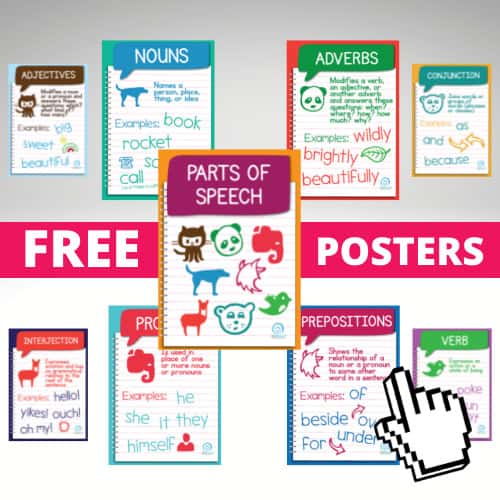
Without a verb, there is no sentence! Verbs are the words we use to represent both internal and external actions or states of being. Without a verb, nothing happens.
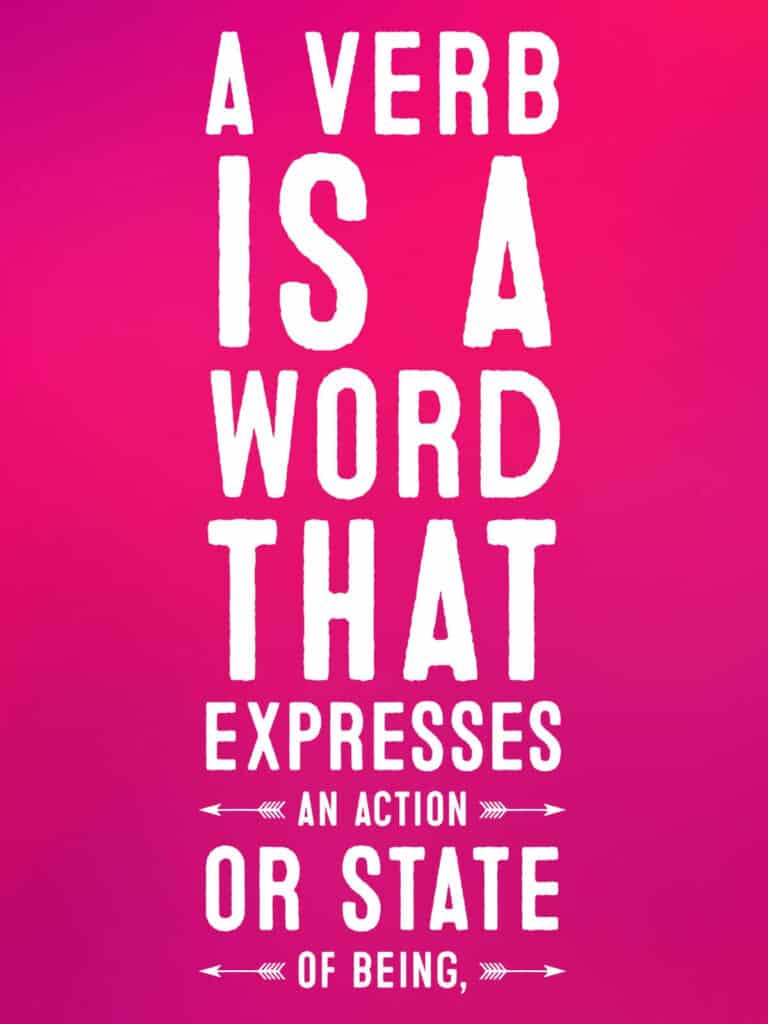
There are many different types of verbs. Here, we will look at five important verb forms organised according to the jobs they perform:
Dynamic Verbs
Stative verbs, transitive verbs, intransitive verbs, auxiliary verbs.
Each verb can be classified as being either an action or a stative verb.
Dynamic or action verbs describe the physical activity performed by the subject of a sentence. This type of verb is usually the first we learn as children.
For example, run , hit , throw , hide , eat , sleep , watch , write , etc. are all dynamic verbs, as is any action performed by the body.
Let’s see a few examples in sentences:
- I jogged around the track three times.
- She will dance as if her life depends on it.
- She took a candy from the bag, unwrapped it, and popped it into her mouth.
If a verb doesn’t describe a physical activity, then it is a stative verb.
Stative verbs refer to states of being, conditions, or mental processes. Generally, we can classify stative verbs into four types:
- Emotions/Thoughts
Some examples of stative verbs include:
Senses: hurt, see, smell, taste, hear, etc.
Emotions: love, doubt, desire, remember, believe, etc.
Being: be, have, require, involve, contain, etc.
Possession: want, include, own, have, belong, etc.
Here are some stative verbs at work in sentences:
- That is one thing we can agree on.
- I remember my first day at school like it was yesterday.
- The university requires students to score at least 80%.
- She has only three remaining.
Sometimes verbs can fit into more than one category, e.g., be , have , look , see , e.g.,
- She looks beautiful. (Stative)
- I look through the telescope. (Dynamic)
Each action or stative verb can also be further classified as transitive or intransitive .
A transitive verb takes a direct object after it. The object is the noun, noun phrase, or pronoun that has something done to it by the subject of the sentence.
We see this in the most straightforward English sentences, i.e., the Subject-Verb-Object or SVO sentence.
Here are two examples to illustrate. Note: the subject of each sentence is underlined, and the transitive verbs are in bold.
- The teacher answered the student’s questions.
- She studies languages at university.
- My friend loves cabbage.
Most sentences in English employ transitive verbs.
An intransitive verb does not take a direct object after it. It is important to note that only nouns, noun phrases, and pronouns can be classed as direct objects.
Here are some examples of intransitive verbs – notice how none of these sentences has direct objects after their verbs.
- Jane’s health improved .
- The car ran smoothly.
- The school opens at 9 o’clock.
Auxiliary verbs, also known as ‘helping’ verbs, work with other verbs to affect the meaning of a sentence. They do this by combining with a main verb to alter the sentence’s tense, mood, or voice.
Auxiliary verbs will frequently use not in the negative.
There are relatively few auxiliary verbs in English. Here is a list of the main ones:
- be (am, are, is, was, were, being)
- do (did, does, doing)
- have (had, has, having)
Here are some examples of auxiliary verbs (in bold) in action alongside a main verb (underlined).
She is working as hard as she can.
- You must not eat dinner until after five o’clock.
- The parents may come to the graduation ceremony.
The Subject-Auxiliary Inversion Test
To test whether or not a verb is an auxiliary verb, you can use the Subject-Auxiliary Inversion Test .
- Take the sentence, e.g:
- Now, invert the subject and the suspected auxiliary verb to see if it creates a question.
Is she working as hard as she can?
- Can it take ‘not’ in the negative form?
She is not working as hard as she can.
- If the answer to both of these questions is yes, you have an auxiliary verb. If not, you have a full verb.
Verbs Teaching Activity: Identify the Verbs
- Instruct students to go through an appropriate text length (e.g., paragraph, page, etc.) and compile a list of verbs.
- In groups, students should then discuss and categorize each verb according to whether they think they are dynamic or stative, transitive or intransitive, and/or auxiliary verbs.
The job of an adjective is to modify a noun or a pronoun. It does this by describing, quantifying, or identifying the noun or pronoun. Adjectives help to make writing more interesting and specific. Usually, the adjective is placed before the word it modifies.
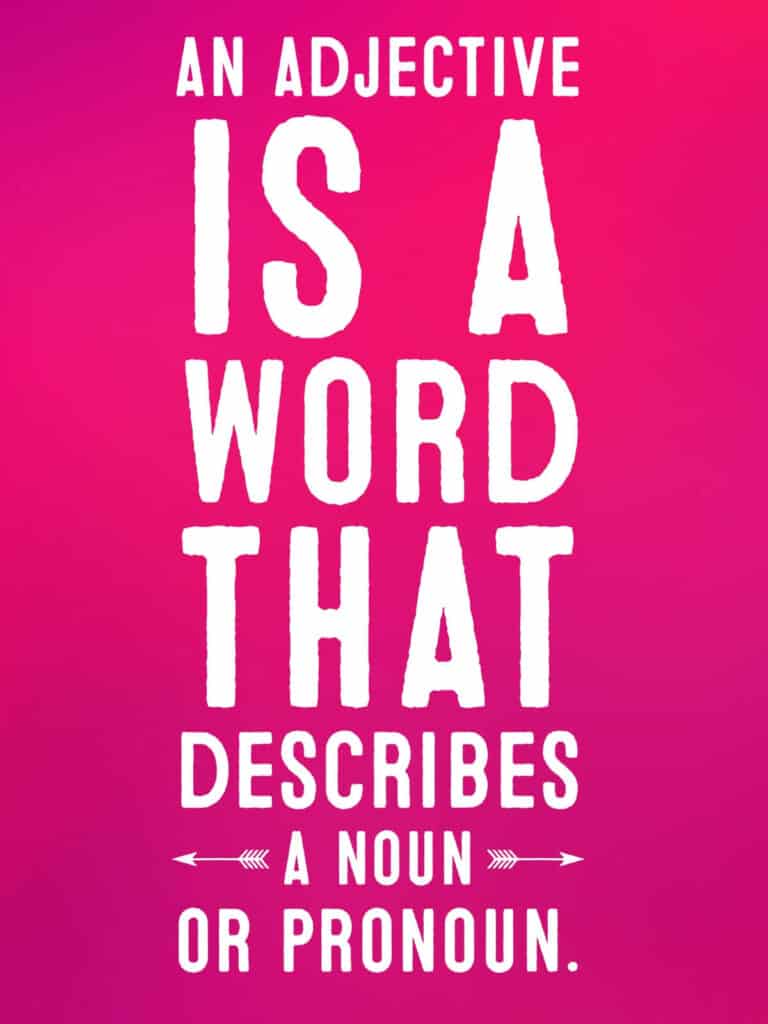
As with other parts of speech, not all adjectives are the same. There are many different types of adjectives and, in this article, we will look at:
Descriptive Adjectives
- Degrees of Adjectives
Quantitative Adjectives
Demonstrative adjectives, possessive adjectives, interrogative adjectives, proper adjectives.
Descriptive adjectives are what most students think of first when asked what an adjective is. Descriptive adjectives tell us something about the quality of the noun or pronoun in question. For this reason, they are sometimes referred to as qualitative adjectives .
Some examples of this type of adjective include:
- hard-working
In sentences, they look like this:
- The pumpkin was enormous .
- It was an impressive feat of athleticism I ever saw.
- Undoubtedly, this was an exquisite vase.
- She faced some tough competition.
Degrees of Adjectives
Descriptive adjectives have three degrees to express varying degrees of intensity and to compare one thing to another. These degrees are referred to as positive , comparative , and superlative .
The positive degree is the regular form of the descriptive adjective when no comparison is being made, e.g., strong .
The comparative degree is used to compare two people, places, or things, e.g., stronger .
There are several ways to form the comparative, methods include:
- Adding more or less before the adjective
- Adding -er to the end of one syllable adjectives
- For two-syllable adjectives ending in y , change the y to an i and add -er to the end.
The superlative degree is typically used when comparing three or more things to denote the upper or lowermost limit of a quality, e.g., strongest .
There are several ways to form the superlative, including:
- Adding most or least before the adjective
- Adding -est to the end of one syllable adjectives
- For two-syllable adjectives ending in y , change the y to an i and add -est to the end.
There are also some irregular adjectives of degree that follow no discernible pattern that must be learned off by students, e.g., good – better – best .
Let’s take a look at these degrees of adjectives in their different forms.
| beautiful | more beautiful | most beautiful |
| delicious | less delicious | least delicious |
| near | nearer | nearest |
| happy | happier | happiest |
| bad | worse | worst |
Let’s take a quick look at some sample sentences:
- It was a beautiful example of kindness.
Comparative
- The red is nice, but the green is prettier .
Superlative
- This mango is the most delicious fruit I have ever tastiest.
Quantitive adjectives provide information about how many or how much of the noun or pronoun.
Some quantitive adjectives include:
- She only ate half of her sandwich.
- This is my first time here.
- I would like three slices, please.
- There isn’t a single good reason to go.
- There aren’t many places like it.
- It’s too much of a good thing.
- I gave her a whole box of them.
A demonstrative adjective identifies or emphasizes a noun’s place in time or space. The most common demonstrative adjectives are this , that , these , and those .
Here are some examples of demonstrative adjectives in use:
- This boat is mine.
- That car belongs to her.
- These shoes clash with my dress.
- Those people are from Canada.
Possessive adjectives show ownership, and they are sometimes confused with possessive pronouns.
The most common possessive adjectives are my , your , his , her , our , and their .
Students need to be careful not to confuse these with possessive pronouns such as mine , yours , his (same in both contexts), hers , ours , and theirs .
Here are some examples of possessive adjectives in sentences:
- My favorite food is sushi.
- I would like to read your book when you have finished it.
- I believe her car is the red one.
- This is their way of doing things.
- Our work here is done.
Interrogative adjectives ask questions, and, in common with many types of adjectives, they are always followed by a noun. Basically, these are the question words we use to start questions. Be careful however, interrogative adjectives modify nouns. If the word after the question word is a verb, then you have an interrogative adverb on hand.
Some examples of interrogative adjectives include what , which , and whose .
Let’s take a look at these in action:
- What drink would you like?
- Which car should we take?
- Whose shoes are these?
Please note: Whose can also fit into the possessive adjective category too.
We can think of proper adjectives as the adjective form of proper nouns – remember those? They were the specific names of people, places, and things and need to be capitalized.
Let’s take the proper noun for the place America . If we wanted to make an adjective out of this proper noun to describe something, say, a car we would get ‘ American car’.
Let’s take a look at another few examples:
- Joe enjoyed his cup of Ethiopian coffee.
- My favorite plays are Shakespearean tragedies.
- No doubt about it, Fender guitars are some of the best in the world.
- The Mona Lisa is a fine example of Renaissance art.
Though it may come as a surprise to some, articles are also adjectives as, like all adjectives, they modify nouns. Articles help us determine a noun’s specification.
For example, ‘a’ and ‘an’ are used in front of an unspecific noun, while ‘the’ is used when referring to a specific noun.
Let’s see some articles as adjectives in action!
- You will find an apple inside the cupboard.
- This is a car.
- The recipe is a family secret.
Adjectives Teaching Activity: Types of Adjective Tally
- Choose a suitable book and assign an appropriate number of pages or length of a chapter for students to work with.
- Students work their way through each page, tallying up the number of each type of adjective they can identify using a table like the one below:
| Descriptive | |
| Comparative | |
| Superlative | |
| Quantitative | |
| Demonstrative | |
| Possessive | |
| Interrogative | |
| Proper | |
| Articles |
- Note how degrees of adjective has been split into comparative and superlative. The positive forms will take care of in the descriptive category.
- You may wish to adapt this table to exclude the easier categories to identify, such as articles and demonstrative, for example.

Traditionally, adverbs are defined as those words that modify verbs, but they do so much more than that. They can be used not only to describe how verbs are performed but also to modify adjectives, other adverbs, clauses, prepositions, or entire sentences.
With such a broad range of tasks at the feet of the humble adverb, it would be impossible to cover every possibility in this article alone. However, there are five main types of adverbs our students should familiarize themselves with. These are:
Adverbs of Manner
Adverbs of time, adverbs of frequency, adverbs of place, adverbs of degree.
Adverbs of manner describe how or the way in which something happens or is done. This type of adverb is often the first type taught to students. Many of these end with -ly . Some common examples include happily , quickly , sadly , slowly , and fast .
Here are a few taster sentences employing adverbs of manner:
- She cooks Chinese food well .
- The children played happily together.
- The students worked diligently on their projects.
- Her mother taught her to cross the road carefully .
- The date went badly .
Adverbs of time indicate when something happens. Common adverbs of time include before , now , then , after , already , immediately , and soon .
Here are some sentences employing adverbs of time:
- I go to school early on Wednesdays.
- She would like to finish her studies eventually .
- Recently , Sarah moved to Bulgaria.
- I have already finished my homework.
- They have been missing training lately .
While adverbs of time deal with when something happens, adverbs of frequency are concerned with how often something happens. Common adverbs of frequency include always , frequently , sometimes , seldom , and never .
Here’s what they look like in sentences:
- Harry usually goes to bed around ten.
- Rachel rarely eats breakfast in the morning.
- Often , I’ll go home straight after school.
- I occasionally have ketchup on my pizza.
- She seldom goes out with her friends.
Adverbs of place, as the name suggests, describe where something happens or where it is. They can refer to position, distance, or direction. Some common adverbs of place include above , below , beside , inside , and anywhere .
Check out some examples in the sentences below:
- Underneath the bridge, there lived a troll.
- There were pizzerias everywhere in the city.
- We walked around the park in the pouring rain.
- If the door is open, then go inside .
- When I am older, I would like to live nearby .
Adverbs of degree express the degree to which or how much of something is done. They can also be used to describe levels of intensity. Some common adverbs of degree include barely , little , lots , completely , and entirely .
Here are some adverbs of degree at work in sentences:
- I hardly noticed her when she walked into the room.
- The little girl had almost finished her homework.
- The job was completely finished.
- I was so delighted to hear the good news.
- Jack was totally delighted to see Diane after all these years.
Adverb Teaching Activity: The Adverb Generator
- Give students a worksheet containing a table divided into five columns. Each column bears a heading of one of the different types of adverbs ( manner , time , frequency , place , degree ).
- Challenge each group to generate as many different examples of each adverb type and record these in the table.
- The winning group is the one with the most adverbs. As a bonus, or tiebreaker, task the students to make sentences with some of the adverbs.

Pronouns are used in place of a specific noun used earlier in a sentence. They are helpful when the writer wants to avoid repetitive use of a particular noun such as a name. For example, in the following sentences, the pronoun she is used to stand for the girl’s name Mary after it is used in the first sentence.
Mary loved traveling. She had been to France, Thailand, and Taiwan already, but her favorite place in the world was Australia. She had never seen an animal quite as curious-looking as the duck-billed platypus.
We also see her used in place of Mary’s in the above passage. There are many different pronouns and, in this article, we’ll take a look at:
Subject Pronouns
Object pronouns, possessive pronouns, reflexive pronouns, intensive pronouns, demonstrative pronouns, interrogative pronouns.
Subject pronouns are the type of pronoun most of us think of when we hear the term pronoun . They operate as the subject of a verb in a sentence. They are also known as personal pronouns.
The subject pronouns are:
Here are a few examples of subject pronouns doing what they do best:
- Sarah and I went to the movies last Thursday night.
- That is my pet dog. It is an Irish Wolfhound.
- My friends are coming over tonight, they will be here at seven.
- We won’t all fit into the same car.
- You have done a fantastic job with your grammar homework!
Object pronouns operate as the object of a verb, or a preposition, in a sentence. They act in the same way as object nouns but are used when it is clear what the object is.
The object pronouns are:
Here are a few examples of object pronouns in sentences:
- I told you , this is a great opportunity for you .
- Give her some more time, please.
- I told her I did not want to do it .
- That is for us .
- Catherine is the girl whom I mentioned in my letter.
Possessive pronouns indicate ownership of a noun. For example, in the sentence:
These books are mine .
The word mine stands for my books . It’s important to note that while possessive pronouns look similar to possessive adjectives, their function in a sentence is different.
The possessive pronouns are:
Let’s take a look at how these are used in sentences:
- Yours is the yellow jacket.
- I hope this ticket is mine .
- The train that leaves at midnight is theirs .
- Ours is the first house on the right.
- She is the person whose opinion I value most.
- I believe that is his .
Reflexive pronouns are used in instances where the object and the subject are the same. For example, in the sentence, she did it herself , the words she and herself refer to the same person.
The reflexive pronoun forms are:
Here are a few more examples of reflexive pronouns at work:
- I told myself that numerous times.
- He got himself a new computer with his wages.
- We will go there ourselves .
- You must do it yourself .
- The only thing to fear is fear itself .
This type of pronoun can be used to indicate emphasis. For example, when we write, I spoke to the manager herself , the point is made that we talked to the person in charge and not someone lower down the hierarchy.
Similar to the reflexive pronouns above, we can easily differentiate between reflexive and intensive pronouns by asking if the pronoun is essential to the sentence’s meaning. If it isn’t, then it is used solely for emphasis, and therefore, it’s an intensive rather than a reflexive pronoun.
Often confused with demonstrative adjectives, demonstrative pronouns can stand alone in a sentence.
When this , that , these , and those are used as demonstrative adjectives they come before the noun they modify. When these same words are used as demonstrative pronouns, they replace a noun rather than modify it.
Here are some examples of demonstrative pronouns in sentences:
- This is delicious.
- That is the most beautiful thing I have ever seen.
- These are not mine.
- Those belong to the driver.
Interrogative pronouns are used to form questions. They are the typical question words that come at the start of questions, with a question mark coming at the end. The interrogative pronouns are:
Putting them into sentences looks like this:
- What is the name of your best friend?
- Which of these is your favourite?
- Who goes to the market with you?
- Whom do you think will win?
- Whose is that?
Pronoun Teaching Activity: Pronoun Review Table
- Provide students with a review table like the one below to revise the various pronoun forms.
- They can use this table to help them produce independent sentences.
- Once students have had a chance to familiarize themselves thoroughly with each of the different types of pronouns, provide the students with the headings and ask them to complete a table from memory.
| | ||||||
| I | me | my | myself | myself | this | what |
| you | you | your | yourself | yourself | that | which |
| he | him | his | himself | himself | these | who |
| she | her | her | herself | herself | those | whom |
| it | it | its | itself | itself | whose | |
| we | us | our | ourselves | ourselves | ||
| you | you | your | yourselves | yourselves | ||
| they | them | their | themselves | themselves |
Prepositions

Prepositions provide extra information showing the relationship between a noun or pronoun and another part of a sentence. These are usually short words that come directly before nouns or pronouns, e.g., in , at , on , etc.
There are, of course, many different types of prepositions, each relating to particular types of information. In this article, we will look at:
Prepositions of Time
Prepositions of place, prepositions of movement, prepositions of manner, prepositions of measure.
- Preposition of Agency
- Preposition of Possession
- Preposition of Source
Phrasal Prepositions
It’s worth noting that several prepositional words make an appearance in several different categories of prepositions.
Prepositions of time indicate when something happens. Common prepositions of time include after , at , before , during , in , on .
Let’s see some of these at work:
- I have been here since Thursday.
- My daughter was born on the first of September.
- He went overseas during the war.
- Before you go, can you pay the bill, please?
- We will go out after work.
Sometimes students have difficulty knowing when to use in , on , or at . These little words are often confused. The table below provides helpful guidance to help students use the right preposition in the right context.
| Centuries YearsSeasonsMonthsTime of day | ||
| DaysDatesSpecific holidays | ||
| Some time of day exceptionsFestivals |
The prepositions of place, in , at , on , will be instantly recognisable as they also double as prepositions of time. Again, students can sometimes struggle a little to select the correct one for the situation they are describing. Some guidelines can be helpful.
- If something is contained or confined inside, we use in .
- If something is placed upon a surface, we use on .
- If something is located at a specific point, we use at .
A few example sentences will assist in illustrating these:
- He is in the house.
- I saw it in a magazine.
- In France, we saw many great works of art.
- Put it on the table.
- We sailed on the river.
- Hang that picture on the wall, please.
- We arrived at the airport just after 1 pm.
- I saw her at university.
- The boy stood at the window.
Usually used with verbs of motion, prepositions of movement indicate movement from one place to another. The most commonly used preposition of movement is to .
Some other prepositions of movement include:
Here’s how they look in some sample sentences:
- The ball rolled across the table towards me.
- We looked up into the sky.
- The children ran past the shop on their way home.
- Jackie ran down the road to greet her friend.
- She walked confidently through the curtains and out onto the stage.
Preposition of manner shows us how something is done or how it happens. The most common of these are by , in , like , on , with .
Let’s take a look at how they work in sentences:
- We went to school by bus.
- During the holidays, they traveled across the Rockies on foot.
- Janet went to the airport in a taxi.
- She played soccer like a professional.
- I greeted her with a smile.
Prepositions of measure are used to indicate quantities and specific units of measurement. The two most common of these are by and of .
Check out these sample sentences:
- I’m afraid we only sell that fabric by the meter.
- I will pay you by the hour.
- She only ate half of the ice cream. I ate the other half.
- A kilogram of apples is the same weight as a kilogram of feathers.
Prepositions of Agency
These prepositions indicate the causal relationship between a noun or pronoun and an action. They show the cause of something happening. The most commonly used prepositions of agency are by and with .
Here are some examples of their use in sentences:
- The Harry Potter series was written by J.K. Rowling.
- This bowl was made by a skilled craftsman.
- His heart was filled with love.
- The glass was filled with water.
Prepositions of Possession
Prepositions of possessions indicate who or what something belongs to. The most common of these are of , to , and with .
Let’s take a look:
- He is the husband of my cousin.
- He is a friend of the mayor.
- This once belonged to my grandmother.
- All these lands belong to the Ministry.
- The man with the hat is waiting outside.
- The boy with the big feet tripped and fell.
Prepositions of Source
Prepositions of source indicate where something comes from or its origins. The two most common prepositions of source are from and by . There is some crossover here with prepositions of agency.
Here are some examples:
- He comes from New Zealand.
- These oranges are from our own orchard.
- I was warmed by the heat of the fire.
- She was hugged by her husband.
- The yoghurt is of Bulgarian origin.
Phrasal prepositions are also known as compound prepositions. These are phrases of two or more words that function in the same way as prepositions. That is, they join nouns or pronouns to the rest of the sentence.
Some common phrasal prepositions are:
- According to
- For a change
- In addition to
- In spite of
- Rather than
- With the exception of
Students should be careful of overusing phrasal prepositions as some of them can seem clichéd. Frequently, it’s best to say things in as few words as is necessary.
Preposition Teaching Activity: Pr eposition Sort
- Print out a selection of the different types of prepositions on pieces of paper.
- Organize students into smaller working groups and provide each group with a set of prepositions.
- Using the headings above as categories, challenge students to sort the prepositions into the correct groups. Note that some prepositions will comfortably fit into more than one group.
- The winning group is the one to sort all prepositions correctly first.
- As an extension exercise, students can select a preposition from each category and write a sample sentence for it.
ConjunctionS

Conjunctions are used to connect words, phrases, and clauses. There are three main types of conjunction that are used to join different parts of sentences. These are:
- Coordinating
- Subordinating
- Correlative
Coordinating Conjunctions
These conjunctions are used to join sentence components that are equal such as two words, two phrases, or two clauses. In English, there are seven of these that can be memorized using the mnemonic FANBOYS:
Here are a few example sentences employing coordinating conjunctions:
- As a writer, he needed only a pen and paper.
- I would describe him as strong but lazy.
- Either we go now or not at all.
Subordinating Conjunctions
Subordinating conjunctions are used to introduce dependent clauses in sentences. Basically, dependent clauses are parts of sentences that cannot stand as complete sentences on their own.
Some of the most common subordinate conjunctions are:
Let’s take a look at some example sentences:
- I will complete it by Tuesday if I have time.
- Although she likes it, she won’t buy it.
- Jack will give it to you after he finds it.
Correlative Conjunctions
Correlative conjunctions are like shoes; they come in pairs. They work together to make sentences work. Some come correlative conjunctions are:
- either / or
- neither / nor
- Not only / but also
Let’s see how some of these work together:
- If I were you, I would get either the green one or the yellow one.
- John wants neither pity nor help.
- I don’t know whether you prefer horror or romantic movies.
Conjunction Teaching Activity: Conjunction Challenge
- Organize students into Talking Pairs .
- Partner A gives Partner B an example of a conjunction.
- Partner B must state which type of conjunction it is, e.g. coordinating, subordinating, or correlative.
- Partner B must then compose a sentence that uses the conjunction correctly and tell it to Partner A.
- Partners then swap roles.
InterjectionS
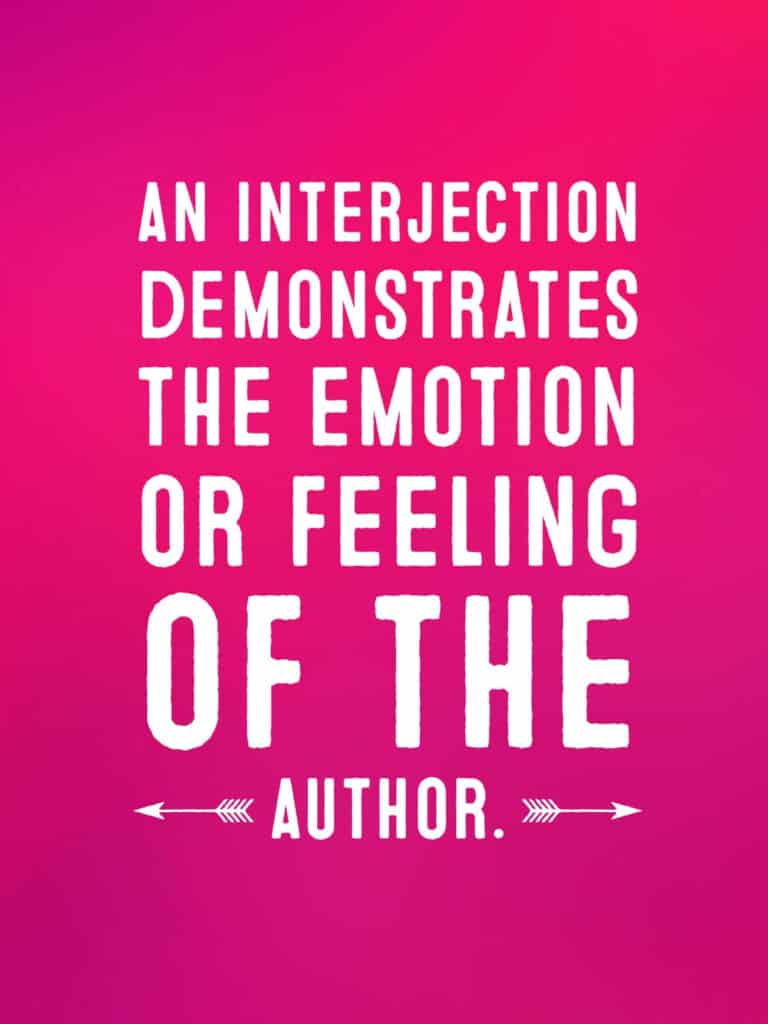
Interjections focus on feelings and are generally grammatically unrelated to the rest of the sentence or sentences around them. They convey thoughts and feelings and are common in our speech. They are often followed by exclamation marks in writing. Interjections include expressions such as:
- Eww! That is so gross!
- Oh , I don’t know. I’ve never used one before.
- That’s very… err …generous of you, I suppose.
- Wow! That is fantastic news!
- Uh-Oh! I don’t have any more left.
Interjection Teaching Activity: Create a scenario
- Once students clearly understand what interjections are, brainstorm as a class as many as possible.
- Write a master list of interjections on the whiteboard.
- Partner A suggests an interjection word or phrase to Partner B.
- Partner B must create a fictional scenario where this interjection would be used appropriately.
With a good grasp of the fundamentals of parts of speech, your students will now be equipped to do a deeper dive into the wild waters of English grammar.
To learn more about the twists and turns of English grammar, check out our comprehensive article on English grammar here.
DOWNLOAD THESE 9 FREE CLASSROOM PARTS OF SPEECH POSTERS

PARTS OF SPEECH TUTORIAL VIDEOS

MORE ARTICLES RELATED TO PARTS OF SPEECH
- English Grammar
- Parts of Speech
Parts of Speech - Definition, 8 Types and Examples
In the English language , every word is called a part of speech. The role a word plays in a sentence denotes what part of speech it belongs to. Explore the definition of parts of speech, the different parts of speech and examples in this article.
Table of Contents
Parts of speech definition, different parts of speech with examples.
- Sentences Examples for the 8 Parts of Speech
A Small Exercise to Check Your Understanding of Parts of Speech
Frequently asked questions on parts of speech, what is a part of speech.
Parts of speech are among the first grammar topics we learn when we are in school or when we start our English language learning process. Parts of speech can be defined as words that perform different roles in a sentence. Some parts of speech can perform the functions of other parts of speech too.
- The Oxford Learner’s Dictionary defines parts of speech as “one of the classes into which words are divided according to their grammar, such as noun, verb, adjective, etc.”
- The Cambridge Dictionary also gives a similar definition – “One of the grammatical groups into which words are divided, such as noun, verb, and adjective”.
Parts of speech include nouns, pronouns, verbs, adverbs, adjectives, prepositions, conjunctions and interjections.
8 Parts of Speech Definitions and Examples:
1. Nouns are words that are used to name people, places, animals, ideas and things. Nouns can be classified into two main categories: Common nouns and Proper nouns . Common nouns are generic like ball, car, stick, etc., and proper nouns are more specific like Charles, The White House, The Sun, etc.
Examples of nouns used in sentences:
- She bought a pair of shoes . (thing)
- I have a pet. (animal)
- Is this your book ? (object)
- Many people have a fear of darkness . (ideas/abstract nouns)
- He is my brother . (person)
- This is my school . (place)
Also, explore Singular Nouns and Plural Nouns .
2. Pronouns are words that are used to substitute a noun in a sentence. There are different types of pronouns. Some of them are reflexive pronouns, possessive pronouns , relative pronouns and indefinite pronouns . I, he, she, it, them, his, yours, anyone, nobody, who, etc., are some of the pronouns.
Examples of pronouns used in sentences:
- I reached home at six in the evening. (1st person singular pronoun)
- Did someone see a red bag on the counter? (Indefinite pronoun)
- Is this the boy who won the first prize? (Relative pronoun)
- That is my mom. (Possessive pronoun)
- I hurt myself yesterday when we were playing cricket. (Reflexive pronoun)
3. Verbs are words that denote an action that is being performed by the noun or the subject in a sentence. They are also called action words. Some examples of verbs are read, sit, run, pick, garnish, come, pitch, etc.
Examples of verbs used in sentences:
- She plays cricket every day.
- Darshana and Arul are going to the movies.
- My friends visited me last week.
- Did you have your breakfast?
- My name is Meenakshi Kishore.
4. Adverbs are words that are used to provide more information about verbs, adjectives and other adverbs used in a sentence. There are five main types of adverbs namely, adverbs of manner , adverbs of degree , adverbs of frequency , adverbs of time and adverbs of place . Some examples of adverbs are today, quickly, randomly, early, 10 a.m. etc.
Examples of adverbs used in sentences:
- Did you come here to buy an umbrella? (Adverb of place)
- I did not go to school yesterday as I was sick. (Adverb of time)
- Savio reads the newspaper everyday . (Adverb of frequency)
- Can you please come quickly ? (Adverb of manner)
- Tony was so sleepy that he could hardly keep his eyes open during the meeting. (Adverb of degree)
5. Adjectives are words that are used to describe or provide more information about the noun or the subject in a sentence. Some examples of adjectives include good, ugly, quick, beautiful, late, etc.
Examples of adjectives used in sentences:
- The place we visited yesterday was serene .
- Did you see how big that dog was?
- The weather is pleasant today.
- The red dress you wore on your birthday was lovely.
- My brother had only one chapati for breakfast.
6. Prepositions are words that are used to link one part of the sentence to another. Prepositions show the position of the object or subject in a sentence. Some examples of prepositions are in, out, besides, in front of, below, opposite, etc.
Examples of prepositions used in sentences:
- The teacher asked the students to draw lines on the paper so that they could write in straight lines.
- The child hid his birthday presents under his bed.
- Mom asked me to go to the store near my school.
- The thieves jumped over the wall and escaped before we could reach home.
7. Conjunctions are a part of speech that is used to connect two different parts of a sentence, phrases and clauses . Some examples of conjunctions are and, or, for, yet, although, because, not only, etc.
Examples of conjunctions used in sentences:
- Meera and Jasmine had come to my birthday party.
- Jane did not go to work as she was sick.
- Unless you work hard, you cannot score good marks.
- I have not finished my project, yet I went out with my friends.
8. Interjections are words that are used to convey strong emotions or feelings. Some examples of interjections are oh, wow, alas, yippee, etc. It is always followed by an exclamation mark.
Examples of interjections used in sentences:
- Wow ! What a wonderful work of art.
- Alas ! That is really sad.
- Yippee ! We won the match.
Sentence Examples for the 8 Parts of Speech
- Noun – Tom lives in New York .
- Pronoun – Did she find the book she was looking for?
- Verb – I reached home.
- Adverb – The tea is too hot.
- Adjective – The movie was amazing .
- Preposition – The candle was kept under the table.
- Conjunction – I was at home all day, but I am feeling very tired.
- Interjection – Oh ! I forgot to turn off the stove.
Let us find out if you have understood the different parts of speech and their functions. Try identifying which part of speech the highlighted words belong to.
- My brother came home late .
- I am a good girl.
- This is the book I was looking for.
- Whoa ! This is amazing .
- The climate in Kodaikanal is very pleasant.
- Can you please pick up Dan and me on your way home?
Now, let us see if you got it right. Check your answers.
- My – Pronoun, Home – Noun, Late – Adverb
- Am – Verb, Good – Adjective
- I – Pronoun, Was looking – Verb
- Whoa – Interjection, Amazing – Adjective
- Climate – Noun, In – Preposition, Kodaikanal – Noun, Very – Adverb
- And – Conjunction, On – Preposition, Your – Pronoun
What are parts of speech?
The term ‘parts of speech’ refers to words that perform different functions in a sentence in order to give the sentence a proper meaning and structure.
How many parts of speech are there?
There are 8 parts of speech in total.
What are the 8 parts of speech?
Nouns, pronouns, verbs, adverbs, adjectives, prepositions, conjunctions and interjections are the 8 parts of speech.
| ENGLISH Related Links | |
Leave a Comment Cancel reply
Your Mobile number and Email id will not be published. Required fields are marked *
Request OTP on Voice Call
Post My Comment
Register with BYJU'S & Download Free PDFs
Register with byju's & watch live videos.
- School Guide
- English Grammar Free Course
- English Grammar Tutorial
- Parts of Speech
- Figure of Speech
- Tenses Chart
- Essay Writing
- Email Writing
- NCERT English Solutions
- English Difference Between
- SSC CGL English Syllabus
- SBI PO English Syllabus
- SBI Clerk English Syllabus
- IBPS PO English Syllabus
- IBPS CLERK English Syllabus
Parts of Speech: Definitions, Examples & 8 Types
Every word is a part of speech playing a specific role in sentences or paragraphs. Parts of speech provide an organized way to align words and phrases, it is a fundamental meaning for a language to become more understandable and serve a specific purpose. Here, in this article, we will see what is Part of Speech, its types, and its uses. So let us dive in deeper to learn more about it!
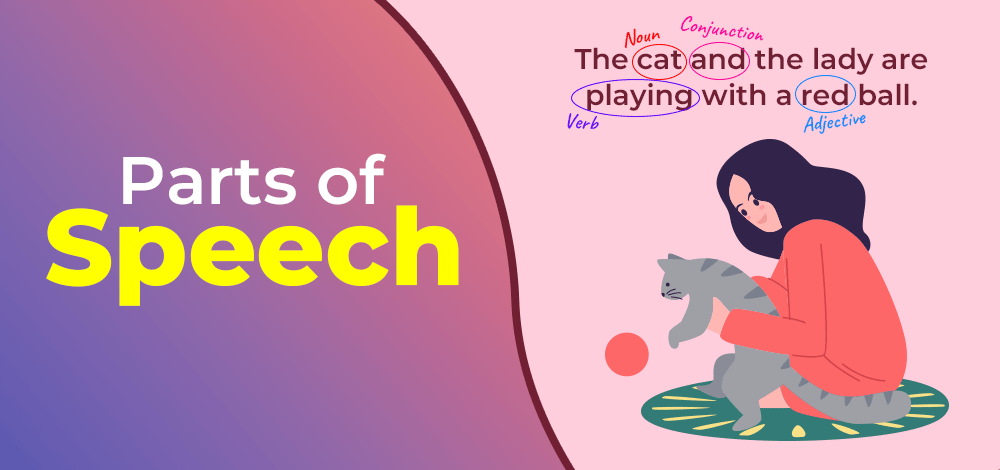
Table of Content
What is Part of Speech?
Parts of speech chart.
- Different Types of Parts of Speech :
- Parts of Speech Examples Using Sentences
- Quiz to practice Parts of Speech
Parts of Speech – FAQs
The English language has thousands of words and every word has some function to perform. Some words are there to show action, some to join, and some to name something. There are 8 different parts of speech including nouns, verbs, adjectives, adverbs, pronouns, prepositions, conjunction, and interjection. And together, all the functions performed by words in the English language fall under Parts of speech.
Parts of Speech Definition
The parts of speech are the “traditional grammatical categories to which words are assigned in accordance with their syntactic functions, such as noun, verb, adjective, adverb, and so on.” In other words, they refer to the different roles that words can play in a sentence and how they relate to one another based on grammar and syntax.
|
| |||
|
| |||
|
|
| ||
|
| |||
|
| |||
|
| |||
|
| |||
|
|
All Parts of Speech with Examples
There are 8 different types of parts of speech i.e., Nouns, Pronouns, Adjectives, Verbs, Adverb, prepositions, Conjunction, and Interjection.
Noun –
A noun is a word that names a person, place, thing, state, or quality. It can be singular or plural. Nouns are a part of speech.
- Function: Refers to Things or person
- Examples: Pen, Chair, Ram, Honesty
- Sentences: Cars are expensive, This chair is made of wood, and Ram is a topper, Honesty is the best policy.
Pronoun –
The word used in place of a noun or a noun phrase is known as a pronoun. A pronoun is used in place of a noun to avoid the repetition of the noun.
- Function: Replaces a noun
- Examples: I, you, he, she, it, they
- Sentences: They are expensive, It is of wood, He is a topper, It is the best policy
Adjective –
A word that modifies a noun or a pronoun is an adjective. Generally, an adjective’s function is to further define and quantify a noun or pronoun.
- Function: Describes a noun
- Examples: Super, Red, Our, Big, Great, class
- Sentences: Supercars are expensive, The red chair is for kids, Ram is a class topper, and Great things take time.
Verb –
A word or a group of words that describes an action, a state, or an event is called a verb. A verb is a word that says what happens to somebody or what somebody or something does.
- Function: Describes action or state
- Sentences: I play football, I will be a doctor, I like to work, I love writing poems.
Adverb –
A verb, adjective, another adverb, determiner, clause, preposition, or sentence is typically modified by an adverb . Adverbs often answer questions like “how,” “in what way,” “when,” “where,” and “to what extent” by expressing things like method, place, time, frequency, degree, level of certainty, etc
- Function: Describes a verb, adjective, or adverb
- Examples: Silently, too, very
- Sentences: I love reading silently, It is too tough to handle, He can speak very fast.
Preposition –
A preposition is called a connector or linking word which has a very close relationship with the noun, pronoun or adjective that follows it . Prepositions show position in space, movement, direction, etc.
- Function: Links a noun to another word
- Examples: at, in, of, after, under,
- Sentences: The ball is under the table, I am at a restaurant, she is in trouble, I am going after her, It is so nice of him
Conjunction –
A conjunction is a word that connects clauses, sentences, or other words. Conjunctions can be used alone or in groups of two.
- Function: Joins clauses and sentences
- Examples: and, but, though, after
- Sentences: First, I will go to college and then I may go to Fest, I don’t have a car but I know how to drive, She failed the exam though she worked hard, He will come after he finishes his match.
Interjection –
An interjection is a word or phrase expressing some sudden feelings of sadness or emotions.
- Function: Shows exclamation
- Examples: oh! wow!, alas! Hurray!
- Sentences: Oh! I got fail again, Wow! I got the job, Alas! She is no more, Hurray! We are going to a party.
These are the main parts of speech, but there are additional subcategories and variations within each. Understanding the different parts of speech can help construct grammatically correct sentences and express ideas clearly.
Sentence Examples for the 8 Parts of Speech
- Examples: Luggage, Cattle.
- Sentence: Never leave your luggage unattended.
- In some places, cattle are fed barely.
- Examples: who, either, themselves
- Sentence: I know a man who plays the guitar very well.
- Either of the two cars is for sale.
- They enjoyed themselves at the party.
- Examples: kind, moving, wounder.
- Sentence:
- She is a kind person.
- Boarding a moving bus can be dangerous.
- Never poke a wounded animal.
- Examples: Praise, Hate, Punish
- Sentence: She always praises her friends.
- I don’t hate anybody.
- The boy has been punished by his teacher
- Examples: Always, enough, immediately
- Sentence: we should always help each other.
- We should be wise enough to understand what is good for us.
- We should leave bad habits immediately.
Preposition
- Examples: Off, Below, From. to
- He plunged off the cliff
- I live below the 9th floor.
- I travel daily from Delhi to Noida.
Conjunction
- Examples: whereas, as well as, so,
- Sentence: The new software is fairly simple whereas the old one was a bit complicated.
- The finance company is not performing well as well as some of its competitors.
- He was ready so he may come.
Interjection
- Examples: oops! whoa! phew!
- Sentence: Oops! I forgot to mention her name.
- Whoa! you drive fast.
- Phew! That was a close call, we had a narrow escape.
Parts of Speech Exercise – Test your Knowledge of Part of speech
Choose the correct Parts of Speech of the BOLD word from the following questions.
1. Let us play, Shall We?
a. Conjunction b. Pronoun c. Verb
2. I t is a good practice to arrange books on shelves.
a. Verb b. Noun c. Adjective
3. Whose books are these?
a. Pronoun b. Preposition c. verb
4. Father, please get me that toy.
a. Pronoun b. Adverb c. Adjective
5. His mentality is rather obnoxious.
a. Adverb b. Adjective c. Noun
6. He is the guy whose money got stolen.
a. Pronoun b. Conjunction c. Adjective
7. I will have finished my semester by the end of this year.
a. Interjection b. Conjunction c. Preposition
8. Bingo! That’s the one I have been looking for
a. Interjection b. Conjunctio c. Preposition
Quiz Answers:
1. c, 2. b, 3. a, 4. c, 5. a, 6. b, 7. c, 8. a
Also Check:
- English Grammar
- Figures of Speech
- Learn English Grammar Online
- Difference Between Adjective and Verb
Q1. What are Parts of Speech?
A word is assigned to a category as per its function, and those categories are together known as Parts of Speech.
Q2. What are the 8 Parts of Speech?
Noun, Pronoun, Adjective, Verb, Adverb, Preposition, Conjunction, Interjection.
Q3. How many Parts of Speech are there?
There are a total of 8 parts of Speech.
Q4. What Part of Speech is “our”?
“Our” is a adjective type of Part of Speech. Eg. Our car.
Q5. What Part of Speech is “Quickly”?
Adverb. let us understand it with this example – Milk sours quickly in warm weather.
Similar Reads
- SSC/Banking
Please Login to comment...
- Ratan Tata Passes Away at 86: A Great Loss for India and the World
- Uber to launch AI Assistant Back by OpenAI's GPT-4o to help Drivers Go Electric
- 10 Best IPTV Services in Sweden (October 2024 Update)
- PS5 Digital vs. Disc : Which PlayStation 5 Should You Buy in 2024?
- GeeksforGeeks Practice - Leading Online Coding Platform
Improve your Coding Skills with Practice
What kind of Experience do you want to share?

IMAGES
VIDEO
COMMENTS
The 9 parts of speech are adjectives, adverbs, conjunctions, determiners, interjections, nouns, prepositions, pronouns, and verbs. (These are also known as "word classes.") A Formal Definition. A "part of speech" is a category to which a word is assigned in accordance with its syntactic functions. In English, the main parts of speech are noun ...
The parts of speech are classified differently in different grammars, but most traditional grammars list eight parts of speech in English: nouns, pronouns, verbs, adjectives, adverbs, prepositions, conjunctions, and interjections. Some modern grammars add others, such as determiners and articles. Many words can function as different parts of ...
What is a Parts of Speech? A part of speech is a category that describes the role a word plays in a sentence.These roles help you understand how words function in grammar.. There are typically eight main parts of speech in English: Nouns: Words that name people, places, things, or ideas.; Pronouns: Words that replace nouns, such as he, she, it.; Verbs: Words that describe actions or states ...
February 8, 2024. What Part of Speech Is the Word "The"? The is the most commonly used word in the English language, according to the Oxford English Corpus, making it one of the most... January 15, 2024. English Prepositions: "In," "On," and "At" The English prepositions in, on, and at are some of the most common words in our ...
The parts of speech refer to categories to which a word belongs. In English, there are eight of them : verbs , nouns, pronouns, adjectives, adverbs, prepositions, conjunctions, and interjections. Many English words fall into more than one part of speech category. Take the word light as an example.
This comes before a noun or a noun phrase and links it to other parts of the sentence. These are usually single words (e.g., on, at, by,…) but can be up to four words (e.g., as far as, in addition to, as a result of, …). I chose to interview teachers in the district closest to me. The recorder was placed next to the interviewee.
Also known as word classes, these are the building blocks of grammar. Every sentence you write or speak in English includes words that fall into some of the nine parts of speech. These include nouns, pronouns, verbs, adjectives, adverbs, prepositions, conjunctions, articles/determiners, and interjections. (Some sources include only eight parts ...
The basic structure of an English sentence consists of a subject, a verb, and an object. For example: Example: The cat (subject) caught (verb) the mouse (object). ... compound, or complex, depending on the number of independent and dependent clauses they contain. Parts of Speech Relationships. English grammar can be broken down into eight ...
The eight parts of speech are nouns, pronouns, adjectives, verbs, adverbs, conjunctions, prepositions, and interjections. You just learned about all of the parts of speech. Give yourself a high five! If you'd like to teach or learn grammar the easy way—with sentence diagrams—check out our Get Smart Grammar Program.
When we talk about 'parts of speech', what we mean is whether a word is a noun or a verb or an adjective or a preposition or something else. Here are some different word categories that we use when we're talking about English grammar. Click on each category for more information. Noun (apple, table, book, beauty, sky, life)
Parts of Speech Defined. In grammar, parts of speech, also referred to as lexical categories, grammatical categories, or word classes, categorize words based on their linguistic functions. These parts play a crucial role in sentence construction by conveying specific meanings and relationships between words. In English, there are eight parts of ...
A subject. A predicate. The subject of a sentence is the person, place, concept, or thing the sentence is about. The predicate is the action the subject is performing or having performed on them; it can also be a description of them. The predicate always contains a verb. Sometimes, a sentence contains only a subject and a verb. Here is an example:
The 8 parts of speech in English are: Nouns, Adjectives, Adverbs, Verbs, Prepositions, Pronouns, Conjunctions, and Interjections. A part of speech is a category of words that have similar grammatical functions or properties. In other words, they play similar roles in a sentence. For instance, a verb shows the action of a subject or the subject ...
There are eight parts of speech in the English language: noun, pronoun, verb, adjective, adverb, preposition, conjunction, and interjection. The part of speech indicates how the word functions in meaning as well as grammatically within the sentence. An individual word can function as more than one part of speech when used in different ...
Parts of speech are word categories defined by their roles in sentence structures. These categories are organized by the functions and meanings they convey. In English, there are around ten common parts of speech: nouns, verbs, adjectives, adverbs, pronouns, prepositions, conjunctions, interjections, determiners, and articles.
The parts of a sentence can be divided into two main parts: Subject: who or what the sentence is about; Predicate: ... 8 Parts of Speech in English Grammar. The 8 parts of speech are Nouns, Adjectives, Adverbs, Verbs, Prepositions, Pronouns, Conjunctions, and Interjections. Learn about the function of each of these grammatical categories.
Parts of speech are the classification of words categorized by their roles and functions within the structure of the language. Parts of speech encompass everything a language has in itself. Can you imagine all the words of a language can be sorted into these categories? They play different roles in the structure of a language.
Instruct students to go through an appropriate text length (e.g., paragraph, page, etc.) and compile a list of verbs. In groups, students should then discuss and categorize each verb according to whether they think they are dynamic or stative, transitive or intransitive, and/or auxiliary verbs.
begins with a preposition and ends with the very next noun or pronoun may have any amount of modifiers. Adjective questions. Which one, how many, what kind/ Type. Adverb questions. When, where, how/in what manner, to what extent. Practice recognizing the 8 parts of speech Learn with flashcards, games, and more — for free.
Here's the thing: I love nouns. But wait! Nouns aren't just things! They can also be people and places. They're my favorite parts of speech. Without them, we'd never be able to talk about *anything*!
8 Parts of Speech Definitions and Examples: 1. Nouns are words that are used to name people, places, animals, ideas and things. Nouns can be classified into two main categories: Common nouns and Proper nouns. Common nouns are generic like ball, car, stick, etc., and proper nouns are more specific like Charles, The White House, The Sun, etc.
Parts of speech What are parts of speech? In English the words or parts of different sentences are called parts of speech. There are eight parts of speech that make our sentences complete. Here different parts of speech are explained with examples in detailed. The different parts of speech are; 1. Noun 2. Pronoun 3. Verb 4. Adjective 5. Adverb 6.
All Parts of Speech with Examples. There are 8 different types of parts of speech i.e., Nouns, Pronouns, Adjectives, Verbs, Adverb, prepositions, Conjunction, and Interjection. Noun -. A noun is a word that names a person, place, thing, state, or quality. It can be singular or plural.